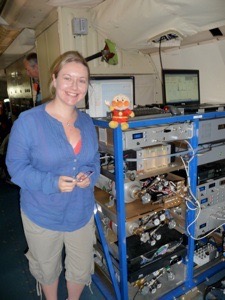News & Fieldwork Index
March 2019
The group webpage is live!!
Future updates on research and fieldwork will be available here
January 2019
Happy New Year!
December 2018
The group presented their work at the AGU Fall Meeting in Washington DC:
Luke Schiferl presented his work on understanding the carbon fluxes of Alaskan Tundra in a very well received oral presentation!
Maggie Powell gave a great poster presentation on her work in the Alaskan tundra during the Polaris Project summer fieldwork from 2018
Roisin presented a poster on the group’s work on the impact of African pollution on the tropical Atlantic, that got some attention.
Just before AGU, Roisin and Luke attended the Permafrost Carbon Network annual meeting in Washington DC. As usual, this was an interesting and exciting meeting with lots of interactions and potential collaborations brewing!
The week before AGU, Roisin gave an invited seminar in the Dept of Physics at University of Toronto, with a quick side trip to visit colleagues at Environment and Climate Change Canada.
November 2018
Roisin attended the NASA ATom Science Team meeting in Boulder, CO and presented the group’s work on African air quality.
October 2018
Roisin attended the CO2-USA (CO2 Urban Synthesis and Analysis Network) workshop in beautiful Salt Lake CIty to learn about carbon fluxes from various urban areas in the US.
Roisin also participated in the Arctic Data Center's Permafrost carbon synthesis working group in Santa Barbara, CA (website). With researchers from Germany, Japan, Korea, US, Canada and Finland, we had a great overview of pan-Arctic flux sites and much progress was made!
September 2018
Group News!
Emily Follansbee has joined the group as a G1 gradutate student in DEES! Welcome Emily!
Maggie Powell is continuing her summer research on Arctic methane into her Senior Research Thesis at Harvard College.
Bronte Dalton is continuing in the group as a research assistant at Lamont for the fall semester, with a continuing focus on developing an urban carbon measurement network.
Roisin presented the group’s work on Arctic carbon in a plenary presentation at the Integrated Carbon Observing System (ICOS) Biannual meeting in Prague, Czech Republic on Sept 12, 2018. She also presented a poster on our work with the ATom CO data at the International Global Atmospheric Chemistry (IGAC) biannual meeting in Takamatsu, Japan on Sept 27, 2018.
July 2018
Margaret Powell spends two weeks in the Yukon-Kuskokwim Delta in south west Alaska as part of the NSF Polaris Project.
June 2018
Roisin is featured as a data provider on NASA Earthdata
Bronte Dalton joins the group as a summer student at Columbia.
April-May 2018
Roisin, Bruce and John fly around the world for ATom4!
April 2018
April 8-14: Roisin, Bruce and John in Palmdale for ATom4 Test Flights!
April 2: First ATom data released on the ORNL DAAC! See ATom data
March 2018
March 27-30: Roisin in Santa Barbara for an Arctic Flux Workshop at NCEAS.
March 19: Sarah Strode’s paper using CO data from ATom1 is on ACPD: Forecasting Carbon Monoxide on a Global Scale for the ATom-1 Aircraft Mission: Insights from Airborne and Satellite observations and modeling
March 19: Roisin quoted in a WaPo article on methane emissions.
March 7-16: Roisin and Bruce Daube travelled to NASA Armstrong in Palmdale, CA to prepare the Harvard QCLS instrument for install on the NASA DC8 research aircraft for NASA ATom Phase 4!
February 2018
Feb 5: Elliott Campbell’s paper on OCS in redwood trees (using data from the CalNex cruise) is featured in the EOS Editor Highlights!
January 2018
Jan 22-26: Roisin and Luke attended the NASA ABoVE meeting in Seattle.
Jan 24: Commane et al., 2017 was mentioned in an NPR article: Is there a ticking time bomb under the Arctic?
Jan 18: Roisin was quoted in a article on Arctic Methane in Earther
Jan 8: Sean Hartery’s paper was published in ACP!
Jan 7-11: Roisin attended the American Meteorological Society’s Atmospheric Chemistry Meeting in Austin, TX to present ATom data:
Jan 2: Luke Schiferl started in the Wofsy/Commane Group at Harvard
December 2017
The AGU session with Roisin’s invited oral presentation is available on Youtube:
October 2017
Completed ATom3 flight circuit - with an added flight under the Antarctic Ozone Hole!
September 2017
Roisin attended the KISS Workshop in Pasadena, CA on Next Generation Approach for Detecting Climate-Carbon Feedbacks: Space-Based Integration of Carbonyl Sulfide (OCS), CO2 and Solar-Induced Fluorescence (SIF)
The four presentations of the Short Course are available online.
May 2017
Intro to Commane et al., 2017: Early Winter Respiration from Alaskan Tundra
March 2017
Roisin attended the SEARCH Methane Workshop in Seattle, WA
March 2017
Chemistry of remote regions: ATom Overview
February 2017
Around the World Again: ATom2
January 2017
Methane publications overview: Regional Methane fluxes in Alaska
August 2016
Around the World Attempt 1: ATom1
June 2016
Intro to Parazoo et al., 2016: Future CO2 in Alaska
December 2015
Intro to Zona et al., 2016: Methane in the Arctic
November 2015
Intro to Commane et al., 2015: Forest Fluxes of Carbonyl Sulfide
October 2015
Carbon Fluxes in the Arctic: CARVE
October 2014
October 2013
Stratospheric CO2 Measurements: SEAC4RS
August 2012
July 2010
Californian Air Quality: CALNEX 2010
October 2009
Greenhouse Gases above the Pacific: HIPPO
July 2008
March 2008
Halogen Oxidation in the Arctic
August 2007
June 2007
Iodine Oxide above the Atlantic
July 2006
Oxidation above the African Sahel: AMMA
ATom4
ATom-4 Media
ATom-4: 24 April - 2 May 2018 Completed
Print
Articles about ATom include:
Roisin’s Profile on NASA Earthdata
Twitter
NASA Armstrong hosted a Media day on Friday April 13th, 2018. Much of the day was shared on social media by a group of invited social media users. You can follow #nasasocial or #NASA_ATom to see more (or click here #NASA_ATom).
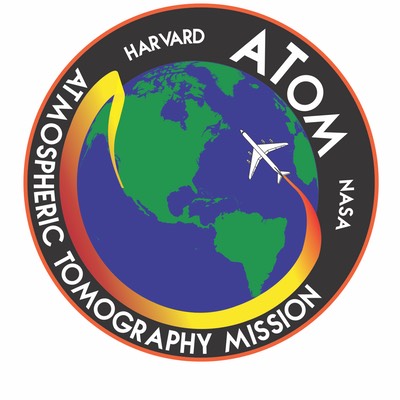
ATom-4 Flights
RF02 - 27 April 2018
ATom-4 RF02 27 April 2018 Palmdale, CA to Anchorage, AK
Our flight to Anchorage was our first flight from home base on the final leg of ATom4. We sampled everything from fires to pollution to stratospheric air so in that sense it was one of the most varied flights we’ve done on ATom.
We flew profiles up the Pacific from California and high across Alaska before profiling at Deadhorse and Utqiavik (Barrow) before landing in Anchorage.
**************************************************************************************
Updates from the field will be made on Twitter by various people (search for #NASA_ATom or just click here for a full overview: #NASA_ATom

ATom-4 Overview
ATom-4: 24 April - 24 May 2018 Complete
Integration of most instruments was completed in March 2018, with test flights beginning on April 12th, 2018.
The plan followed much of the ATom3 flight tracks (with the flight over Antarctica from Punta Arenas, Chile) and a stop in Recife, Brazil instead of Ascension and Cape Verde.
Flights are planned for the dates below (YYYYMMDD, Flight number, Departure location, Arrival location).
20180424: RF01 Palmdale, CA - Palmdale, CA
20180427: RF02 Palmdale, CA - Anchorage, AK
20180429: RF03 Anchorage, AK - Kona, HI
20180501: RF04 Kona, Hawaii - Nadi, Fiji
20180504: RF05 Nadi, Fiji - Christchurch, New Zealand
20180507: RF06 Christchurch, New Zealand - Punta Arenas, Chile
20180509: RF07 Punta Arenas, Chile - Punta Arenas, Chile
20180512: RF08 Punta Arenas, Chile - Recife, Brazil
20180514: RF09 Recife, Brazil - Lajes, Azore Islands
20180517: RF10 Lajes, Azore Islands - Kangerlusaak, Greenland
20180519: RF11 Bangor, Maine - Anchorage, AK
20180521: RF12 Anchorage, AK - Palmdale, CA
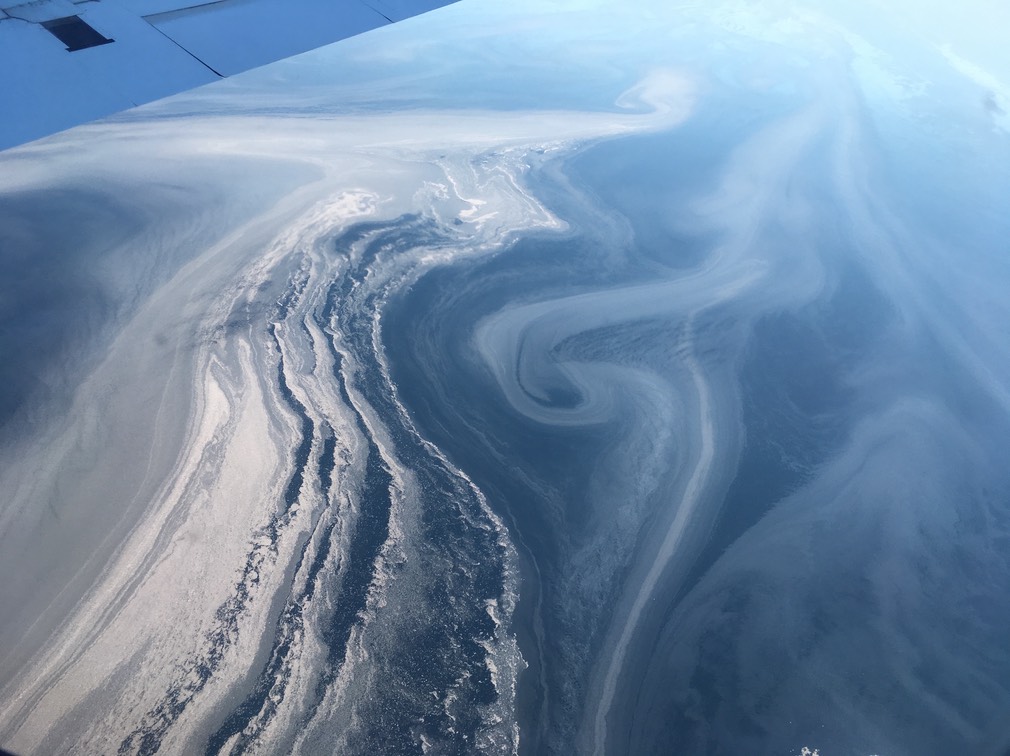
Eddy in sea ice in the Beaufort Sea north of Alaska
Updates from the field were made on Twitter by various people (search for #NASA_ATom or just click here for a full overview: #NASA_ATom.

ATom Overview and Updates
Atmospheric Tomography (ATom)
The ATom project is a NASA EV2 project to understand the composition of the atmosphere around the world over 4 seasons. Flying on the NASA DC8 research aircraft, which is based in Palmdale, California, the flights flew between California and Alaska before proceeding down the Pacific basin to Christchurch, New Zealand, across the southern ocean to Punta Arenas, Chile and up over the Atlantic to Greenland and back to California.
On each of the flights sampled the atmosphere from the boundary layer to the upper troposphere/stratosphere with constant profiling between each altitude. The characteristics of particles and over 300 hundred trace gases were sampled by the various instruments on board. The interpretation of the data is ongoing and will examine a large range of questions about atmospheric composition.
The schedule for the ATom flights covers each of the seasons:
ATom-1: 29 July - 23 August 2016 completed
ATom-2: 26 Jan. - 22 February 2017 completed
ATom-3: 26 Sept. - 30 October 2017 completed
ATom-4: April/May 2018 underway
Harvard QCLS instrument
With Bruce Daube, I am co-Investigator on the Harvard Quantum Cascade Laser Spectrometer (QCLS) that measures CO2, CH4, N2O and CO using two complementary instruments. Both instruments use the absorption of specific wavelengths of infra-red radiation by some trace gases to quantify the gases. For CO2, we measure the difference between the atmosphere and a reference cell. For CH4, N2O and CO, we use two separate lasers with a multi-pass cell to improve the precision. The QCLS instrument is NCAR owned and Harvard operated and has flown on projects such as HIPPO, CalNex, and ORCAS previously.
Follow @ATom_Harvard or @roseAtmos for more updates.
During ATom-1, some of the scientists wrote blog posts describing the day-to-day activities. Links to my posts are on the ATom1 Field Blog page. NASA also produced some excellent videos to descibe our mission using some of my sketchy attempts at videography as well as their own footage from the Palmdale-Palmdale flight. Links to these videos are on my ATom1 Videos page.
For ATom2, we continued our outreach efforts with blog entries, videos and radio interviews. I also uploaded brief post-flight updates for each flight when possible. See the ATom2 Flight page for more details.
For ATom3, we continued our outreach efforts with blog entries and media. I also uploaded brief post-flight updates for each flight when possible. See the ATom3 Flight page for more details.
For ATom4, we continued our outreach efforts with a NASA Social visit to the DC8 during Test Flight 2. See the ATom3 Flight page for more details.

ATom3
ATom-3 Overview
ATom-3: 26 September - 28 October 2017 Completed
Integration of most instruments was completed in August 2017, with test flights beginning on Sept 11th, 2017.
The plan followed much of the ATom2 flight tracks with additional flights over Antarctica (from Punta Arenas, Chile) and a stop in Cape Verde. We also ended up in Bangor, Maine instead of Thule due to weather so the winter gear wasn’t needed that much this time.
Flights were completed on the dates below (YYYYMMDD, Flight number, Departure location, Arrival location).
20171028: RF01 Palmdale, CA - Palmdale, CA
20171001: RF02 Palmdale, CA - Anchorage, AK
20171004: RF03 Anchorage, AK - Kona, HI
20171006: RF04 Kona, Hawaii - Nadi, Fiji
20171008: RF05 Nadi, Fiji - Christchurch, New Zealand
20171011: RF06 Christchurch, New Zealand - Punta Arenas, Chile
20171014: RF07 Punta Arenas, Chile - Punta Arenas, Chile
20171017: RF08 Punta Arenas, Chile - Ascension Island
20171019: RF09 Ascension Island - Cape Verde Islands
20171020: RF10 Cape Verde Islands - Lajes, Azore Islands
20171023: RF11 Lajes, Azore Islands - Bangor, Maine
20171025: RF12 Bangor, Maine - Anchorage, AK
20171027: RF13 Anchorage, AK - Palmdale, CA

Eddy in sea ice in the Beaufort Sea north of Alaska
Updates from the field were made on Twitter by various people (search for #NASA_ATom or just click here for a full overview: #NASA_ATom.

ATom-3 Flights
RF07 - 14 October 2017
ATom-3 RF07 14 October 2017 To 80S over Antartica
Our flight south from Punta Arenas was a new addition to our route. This was a special addition as our flights coincided with the peak of the Stratospheric Ozone hole (Southern hemisphere spring).
The DC8 can’t fly high enough to sample the stratosphere itself but we sampled the air just below the stratosphere. This region of the world is difficult to get to and operate in so airborne measurements here are scarse. Our flight there have vastly increased the number of measurements here.
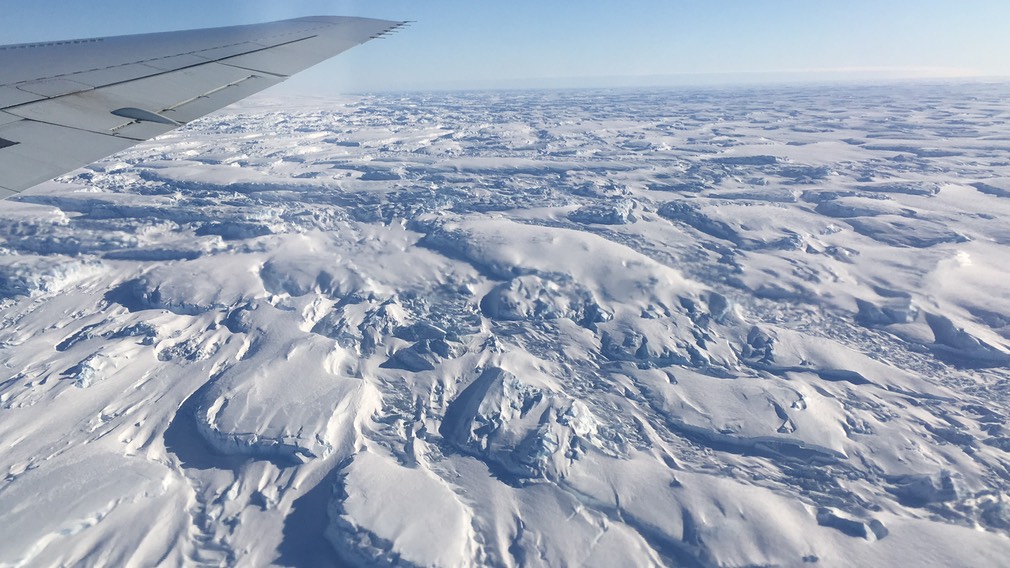
Over Antarctica
We didn’t see any penguins by design. We planned the flight to avoid their colonies (it’s baby penguin season!) so as not to stress them out. I guess I will have to wait for another chance to see some penguins in the wild!
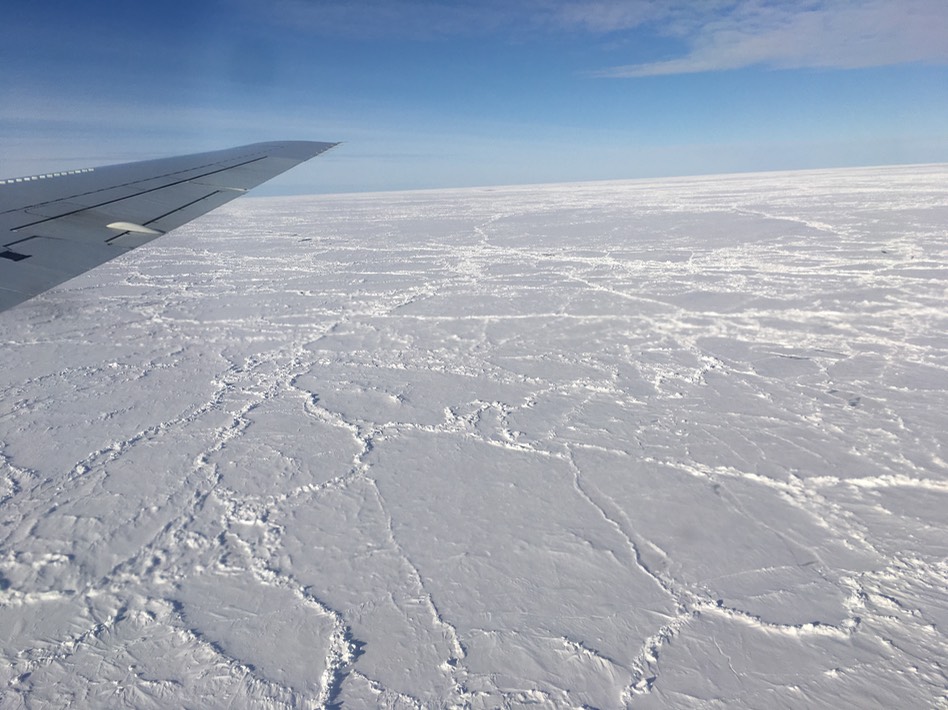
Solid Sea Ice in the Weddell Sea
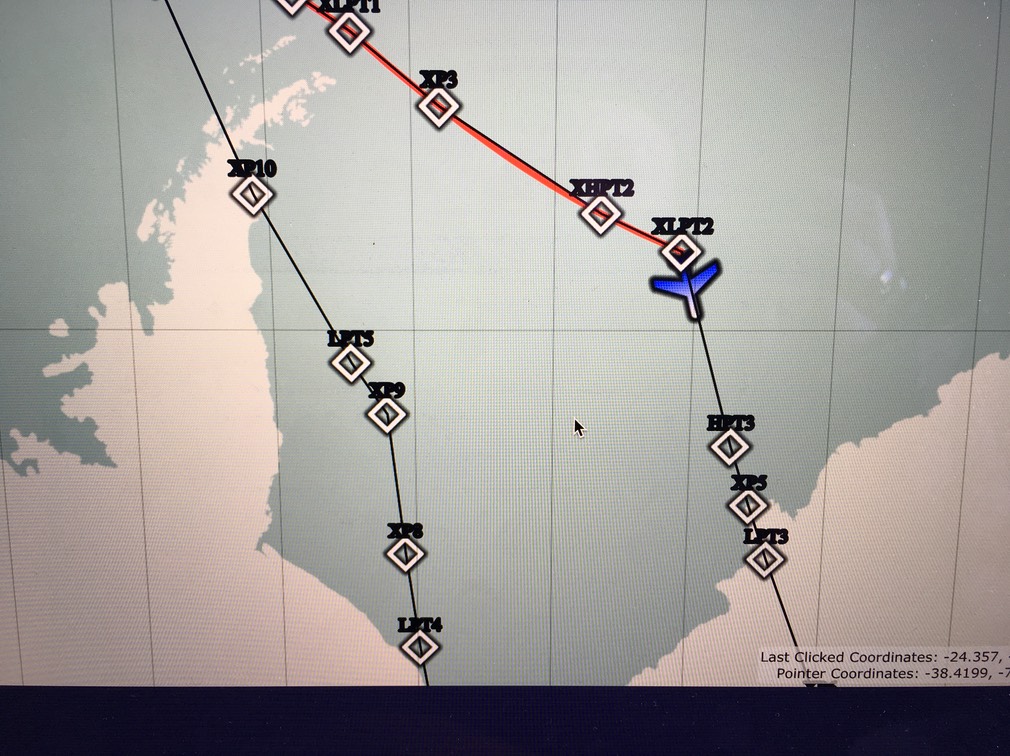
On our way south to 80oS, we did lots of profiles between 30,000 ft and 500 ft.
**************************************************************************************
Updates from the field will be made on Twitter by various people (search for #NASA_ATom or just click here for a full overview: #NASA_ATom

ATom-3 Media
ATom-3: 26 September - 28 October 2017 Completed
Print
Articles about ATom include:
NASA Goddard - Ozone Hole Detour
Denver Post - Airborne CAT Scan
Harvard Crimson - Interview with Steve Wofsy
Twitter
A collection of some of the ATom3 Twitter posts in an ATom3 Moment
Updates from the field were made on Twitter by various people (search for #NASA_ATom or just click here for a full overview: #NASA_ATom.

ATom2
ATom-2 Overview 2
ATom-2: 26 January - 22 February 2017 Completed
Integration of most instruments was completed in December 2016, with test flights beginning on Jan 11th, 2017.
The plan followed the previous flight tracks with Fiji substituted for American Samoa and Thule filling in for Kangerlusuuaq in Greenland this time. Alaska and Greenland in February will be very (very!) different from August so I will be bringing my winter gear!
Flights were completed on the dates below (YYYYMMDD, Flight number, Departure location, Arrival location). Brief updates on the flight and locations we visited are available at the links below.
20170126: RF01 Palmdale, CA - Palmdale, CA
20170129: RF02 Palmdale, CA - Anchorage, AK
20170201: RF03 Anchorage, AK - Kona, HI
20170203: RF04 Kona, Hawaii - Nadi, Fiji
20170205: RF05 Nadi, Fiji - Christchurch, New Zealand
20170210: RF06 Christchurch, New Zealand - Punta Arenas, Chile
20170213: RF07 Punta Arenas, Chile - Ascension Island
20170215: RF08 Ascension Island - Lajes, Azore Islands
20170218: RF09 Lajes, Azore Islands - Thule, Greenland
20170220: RF10 Thule, Greenland - Anchorage, AK
20170221: RF11 Anchorage, AK - Palmdale, CA
Media coverage of ATom2 included radio, video and print media.
Updates from the field were made on Twitter by various people (search for #NASA_ATom or just click here for a full overview: #NASA_ATom.
ATom2 data has been released to the public and can be found on the NASA ESPO archive.

ATom-2 Media
ATom-2: 26 January - 22 February 2017 Completed
Radio
WGBH reporter Craig LeMoult travelled with use from Palmdale to Anchorage and he prepared a number of great radio pieces from his time with us that have aired on National Public Radio (NPR) in the US. Apologies for the flat Irish accent in many of them!
Lab-in-a-Plane Making Four Laps around the Globe, Living Lab on the Point, WCAI, February 7, 2017
Scientists use flying laboratory to track greenhouse gases, Morning Edition, WGBH, February 20, 2017
Print
Articles about ATom include:
NASA Airborne mission chases air pollution through the seasons in phys.org
NASA Flying around the world in 26 days
Video
Video Postcards produced by NASA are available at:
Alaska and the Arctic: https://www.youtube.com/watch?v=SsOuiit2FKw
Hawaiian Volcanos: https://www.youtube.com/watch?v=f77bVHtpX0E
Ascension Island to the Azores:
Update from the #EarthExpedition ATom mission sampling world-wide in one of the most extensive surveys of the atmosphere to date. pic.twitter.com/HxtdAjkJ1R
— NASA Earth (@NASAEarth) March 20, 2017
Facebook Link: https://www.facebook.com/nasaearth/videos/10155203215612139
Updates from the field were made on Twitter by various people (search for #NASA_ATom or just click here for a full overview: #NASA_ATom.

ATom-2 Flights
RF11 - 21 February 2017
ATom-2 RF11 21 February 2017 Anchorage - Palmdale
Our final research flight travelled back south and east from Anchorage, Alaska to the home base of the DC8 in Palmdale, California.
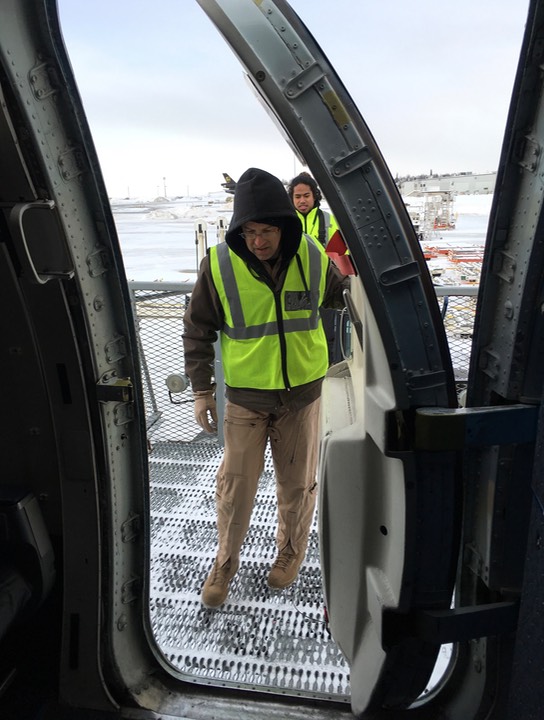
As we arrived in Anchorage an day earlier than expected, the aircraft had to stay outside with a heater cart pumping in hot air overnight. That meant that two people had to be with it at all times. I offered to take the first 3 hour shift with Tim as I thought it was the easiest to deal with. Brownie points go to others who took the much later shifts!
Our final flight from Anchorage back into Palmdale, was a short 6 hours that was pretty much a blur for me. We are currently offloading all the instruments. It took us nearly a month to put everything carefully on the aircraft in just the way we wanted it. But we have just two days to rip it all off again, box it up and send it home. It makes the end of the project even more hectic than the deployment but we can always sleep when we get home!
**************************************************************************************
Updates from the field will be made on Twitter by various people (search for #NASA_ATom or just click here for a full overview: #NASA_ATom

RF10 - 19 February 2017
ATom-2 RF10 19 February 2017 Thule - Anchorage
Our tenth research flight travelled across the northern edge of the globe from Thule Air Force Base, Greenland to Anchorage, Alaska via 82oN.
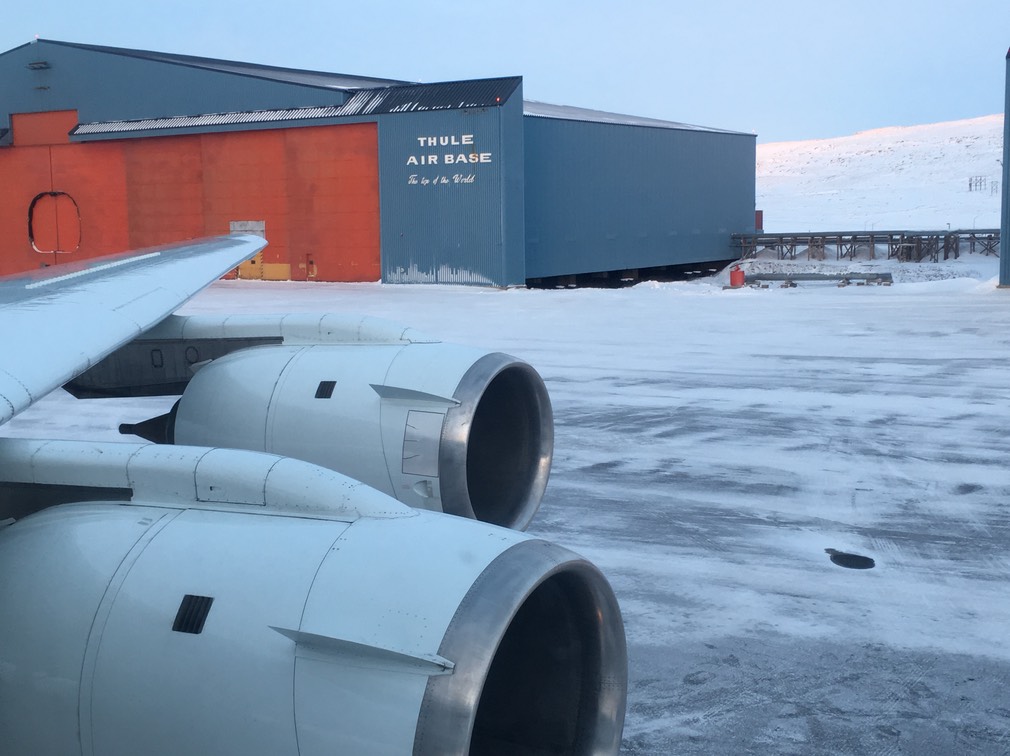
This was my first trip to Thule and is the furthest north I’ve ever been (on the ground anyway) at 76oN. The air temperature was a brisk -25oC (-30oC with the wind chill) when we arrived. I always turn bright pink in cold like this and no matter how well I try to protect my face, it doesn’t seem to help! But when dusk arrived, the wind picked up and the temperature was biting on my eyes as we left the dining hall.
We arrived just after noon and saw a little sliver of sunlight on the ground. It turns out this was the first direct sunlight the town has seen all year! This means a “first light” party with full costumes! Unfortunately, with a 4am start to leave Lajes on time, I was fast asleep in bed by 9pm Thule time (or midnight Lajes time) and missed the party. I was feeling bad/old until I heard that the more junior graduate students didn’t make it either :)
I was really surprised by Thule. The food was great and the rooms were cosy and one particular highlight was free laundry! I had a load of washing in the machine within 5 minutes of getting to my room. It was desperately needed too! I hadn’t washed any clothes since Christchurch and my reserves were pretty low. 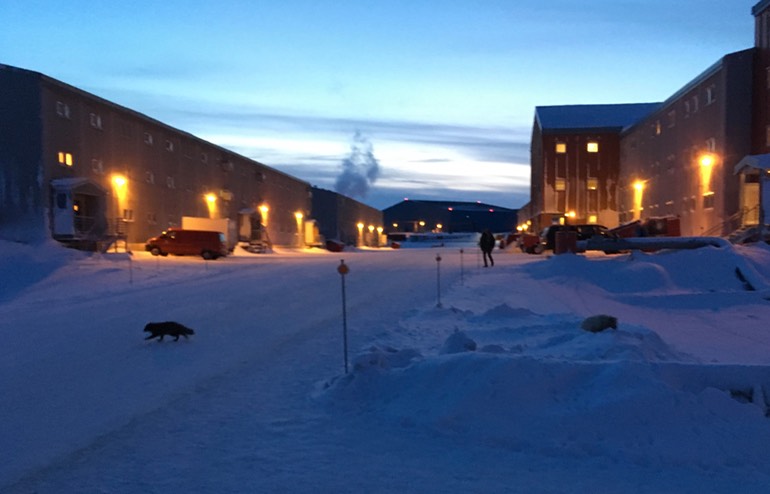
I even got to see the three (one white and two black) resident arctic foxes, who were very well fed little balls of fluff! They weren’t afraid of people but kept a respectable distance to still be considered ‘wildlife'.
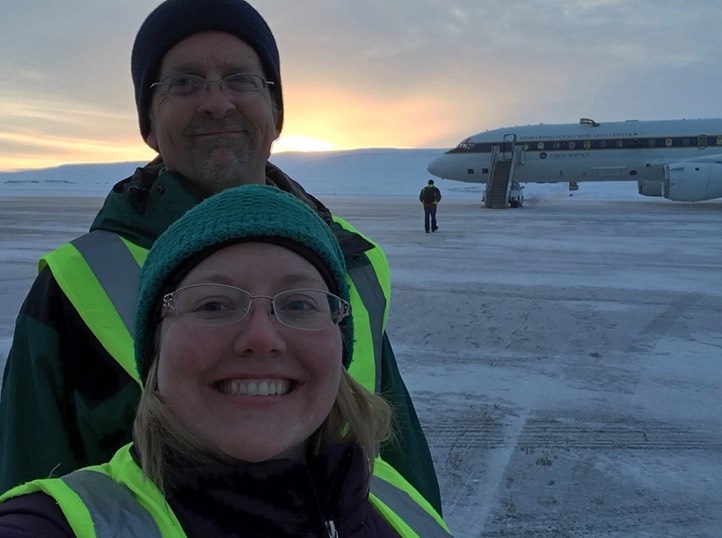
We started pre-flight at a nice leisurely 9.30am and left Thule a little after noon (you can almost see the sun!). We then chased the sun west across the Arctic ocean to Alaska.
On our flight, we flew north out of Thule to 82oN and across northern Canada to Alaska where we did missed approaches over Utqiagvik (Barrow), Deadhorse and Fairbanks before landing in Anchorage.
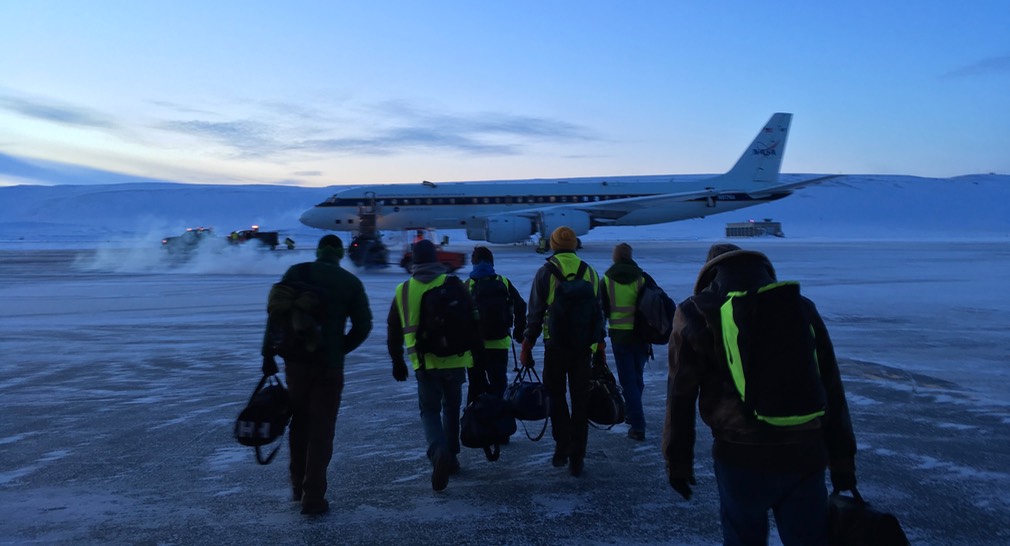
On this and especially on our next flight leaving Thule to fly across northern Canada to Alaska, we saw the highest levels of pollution (besides the African fires) of the entire of ATom2. CO2, CH4, and CO were all really high in layers right down at the surface and there was a lot of sulfur in this air too. And some of the pollution extended right up to the top of the troposphere. In contrast, on ATom1, when we didn’t fly over northern Canada, we saw fires from Siberia just north of Alaska, but the constant summer sunshine there was no cold dome then.
We also saw a lot of thin broken sea ice as we flew along. Translucent layers of ice were forming over the open water areas we saw when we flew over on January 29th. The 2016/2017 winter saw the lowest sea ice ever observed by satellite and it’s scary to see it in person…
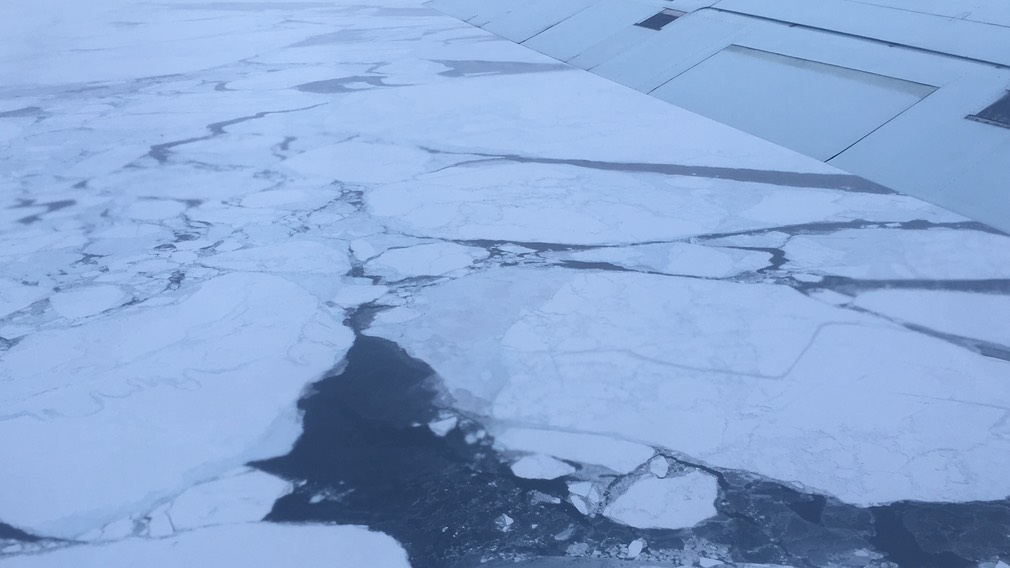
**************************************************************************************
Updates from the field will be made on Twitter by various people (search for #NASA_ATom or just click here for a full overview: #NASA_ATom

RF09 - 18 February 2017
ATom-2 RF09 18 February 2017 Lajes - Thule
Our ninth research flight travelled north again from Lajes to Thule Air Force Base, Greenland.
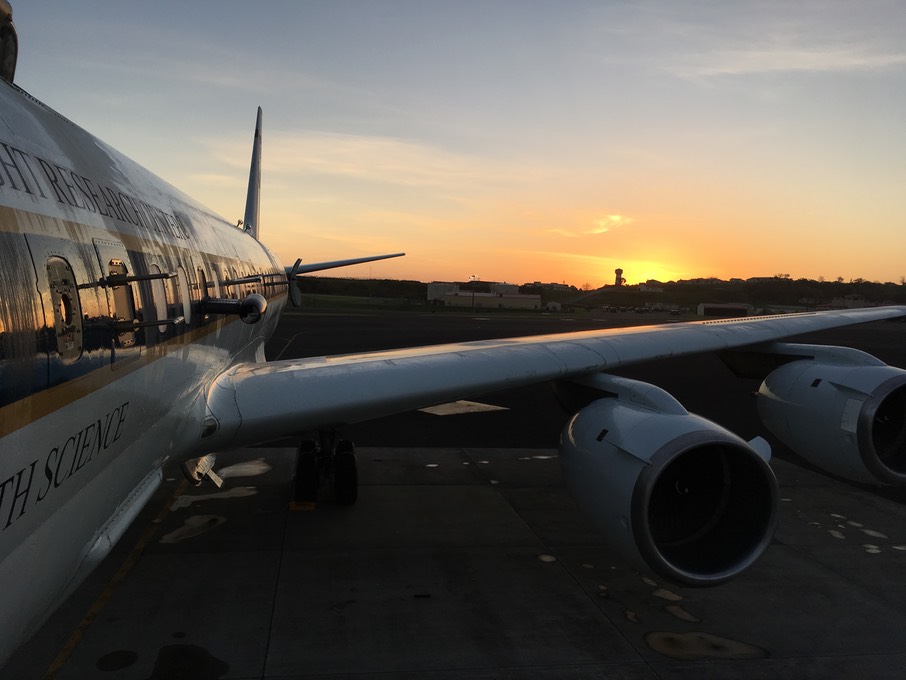
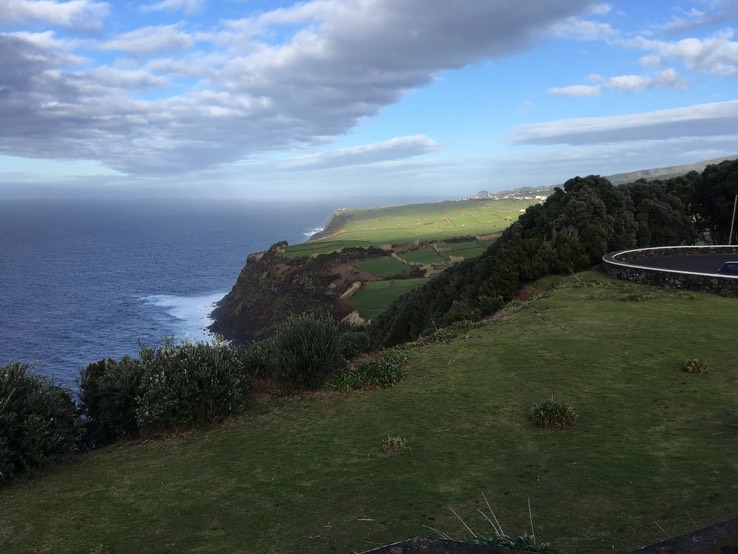
The island of Terceira is a favorite stop of scientists and crew alike. The people are lovely, the food is amazing and the sights are phenomenal! For me, it’s still hard to believe this isn’t the west of Ireland, stone walls and all! But then the sunshine arrives :)
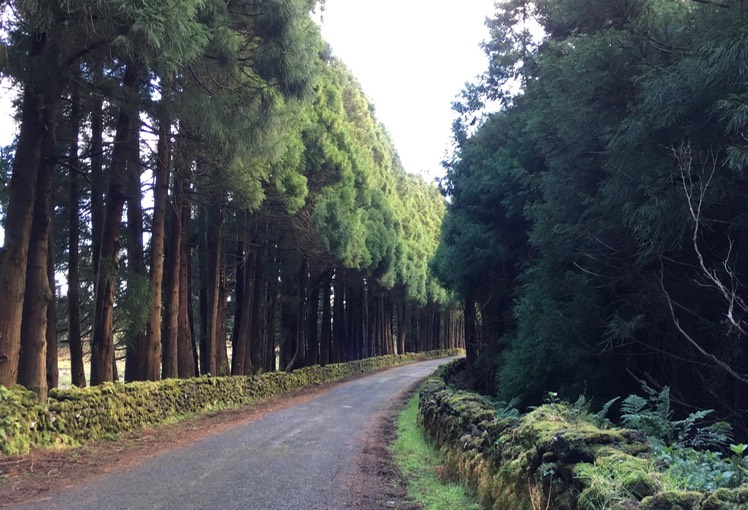
Unfortunately all the volcanic caves were closed as it’s the offseason and one local apologized for the bad weather. If this is as bad as the weather gets, I want to retire here!
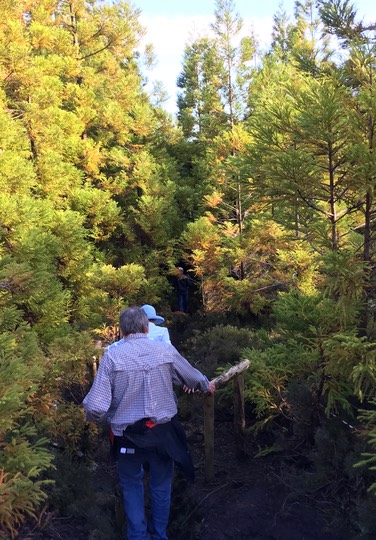
We went for a wander around the trails in the nature preserve in the center of the island. It was muddy but a lot of fun!
Our flight from Lajes to Thule saw us pick our way between two large North Atlantic low pressure regions. We flew over the high Greenland plateau and into the Cold dome of the arctic north. This is where the cold air is trapped at the surface and acts as a winter-time storage area for much of the world’s pollution. We saw high levels of pollution such as short lived hydrocarbons that would normally be oxidized quickly in warmer and sunnier regions.
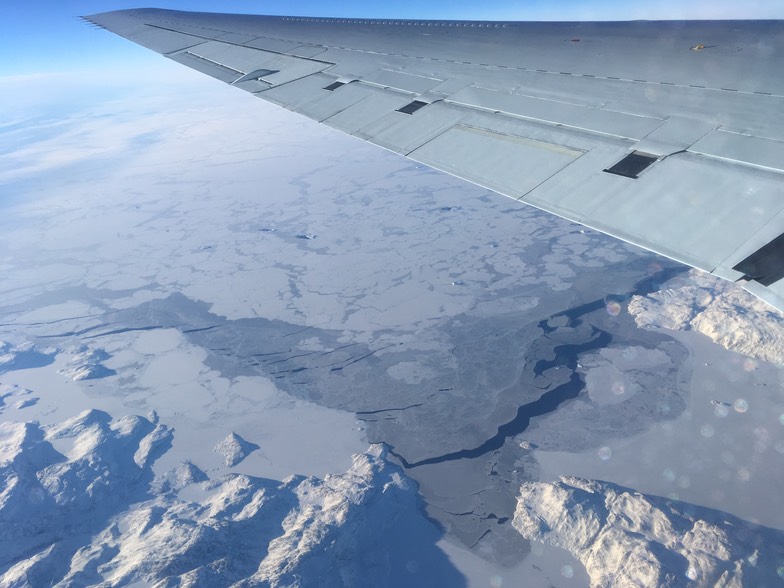
During the flight we saw a lot of broken and missing sea ice as we travelled up the west coast of Greenland. Some exposed sea surface is common in the area as polynya’s form but I was surprised to see so much thin ice (the almost see through ice in this photo).
We are expecting to have pretty cold temperatures in Thule once we arrive. It will be a change from Terceira!
**************************************************************************************
Updates from the field will be made on Twitter by various people (search for #NASA_ATom or just click here for a full overview: #NASA_ATom

RF08 - 15 February 2017
ATom-2 RF08 15 February 2017 Ascension - Lajes
Our eighth research flight travelled north again from Ascension to Lajes on the island of Terceira, the easternmost island of the Azores.
This was our second trip to Ascension and things seemed a lot more familiar, including the warm welcome from the base commander. We knew to expect basic but clean housing on the American Air Force base and we were pleasantly surprised to find a low bandwith wifi set up for us. But the meal schedule still took a bit of getting used to: 4pm dinner seemed a little too soon after 11am lunch!
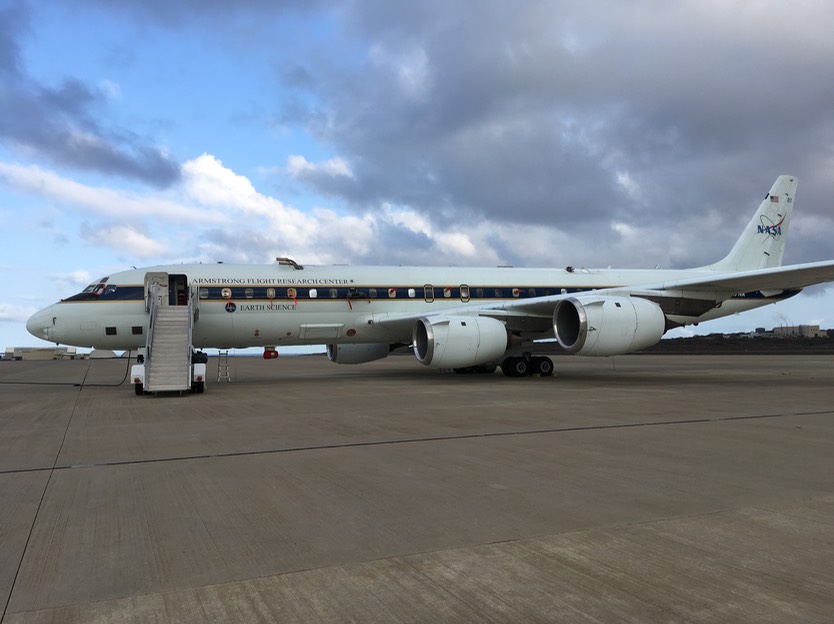
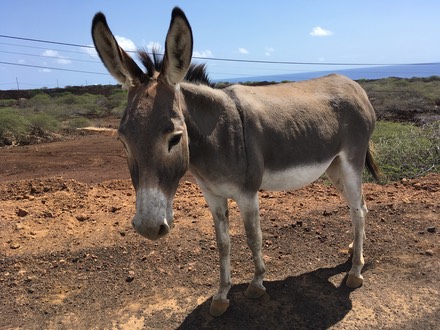
Our wild donkey and wild sheep friends were around but no sign of any land crabs this time anywhere except on the runway on the afternoon before flight!
After working on the aircraft in the morning, we took some time to hike around Green Mountain, the highest point on the island. At low heights near the water, Ascension is like Mars: there are volcanic rocks and clinka (bits of broken off volcanic rocks) everywhere but no vegetation. It’s hot and extremely dry but the beaches are spectacular! Inland a little, clouds from the Atlantic collide with the mountains to create what’s called orographic precipitation: the mountains cause rain! When the island was discovered by the British, an experiment was started to grow all kinds of crops. This makes for a very interesting contrast where banana groves, concede to grass and then rock as you look down to the sea.
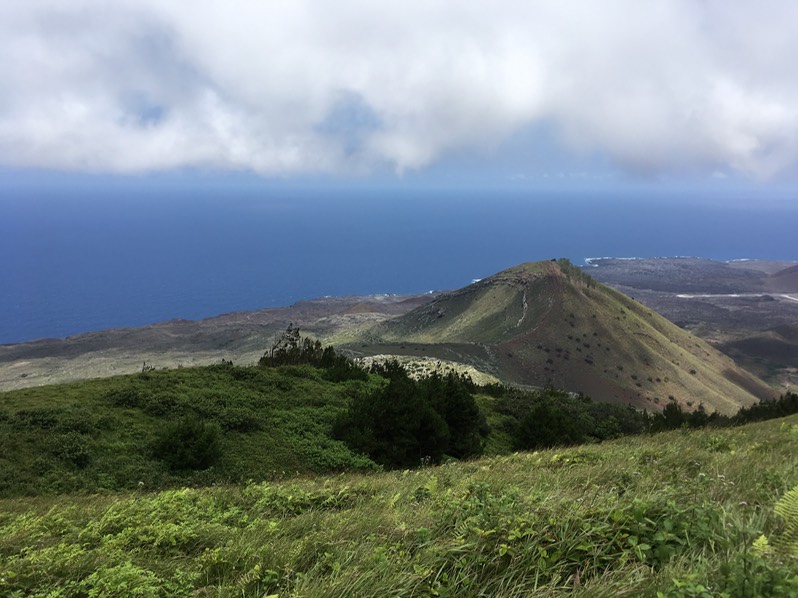
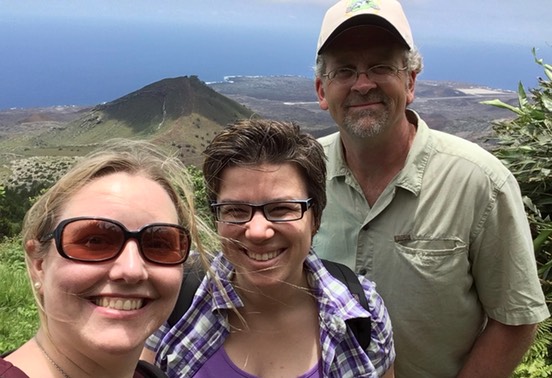
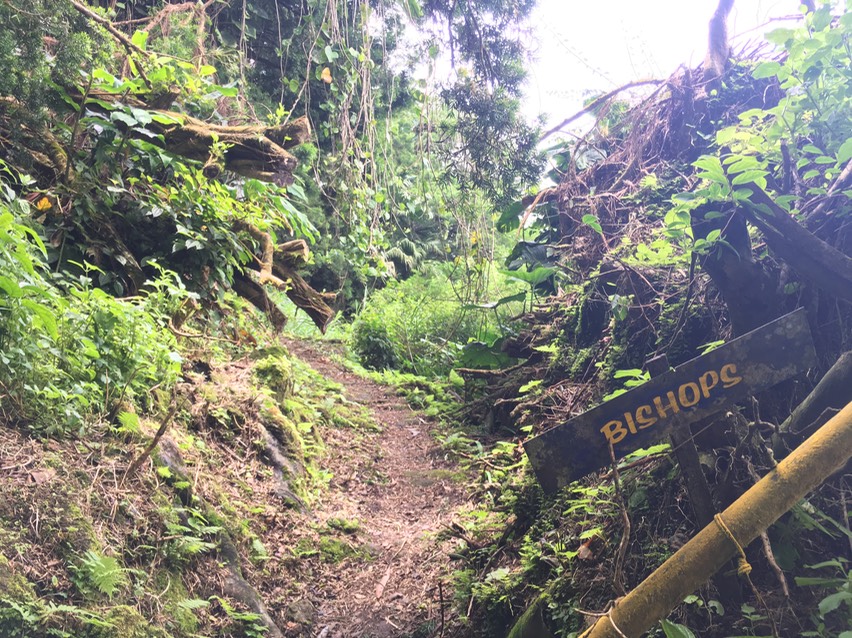
While I failed to see any penguins, I did get to see a giant green turtle lay her eggs on the beach in Ascension! Obviously taking a photo of that at night didn’t work but the beaches were covered in turtle tracks and nests which we saw when going down to the beach for sunset! When we were here in August, the beach was pretty smooth and there were no nests anywhere! If we had landed a day or two earlier, we may have been able to see the turtle hatchlings emerging from the nests at full moon!
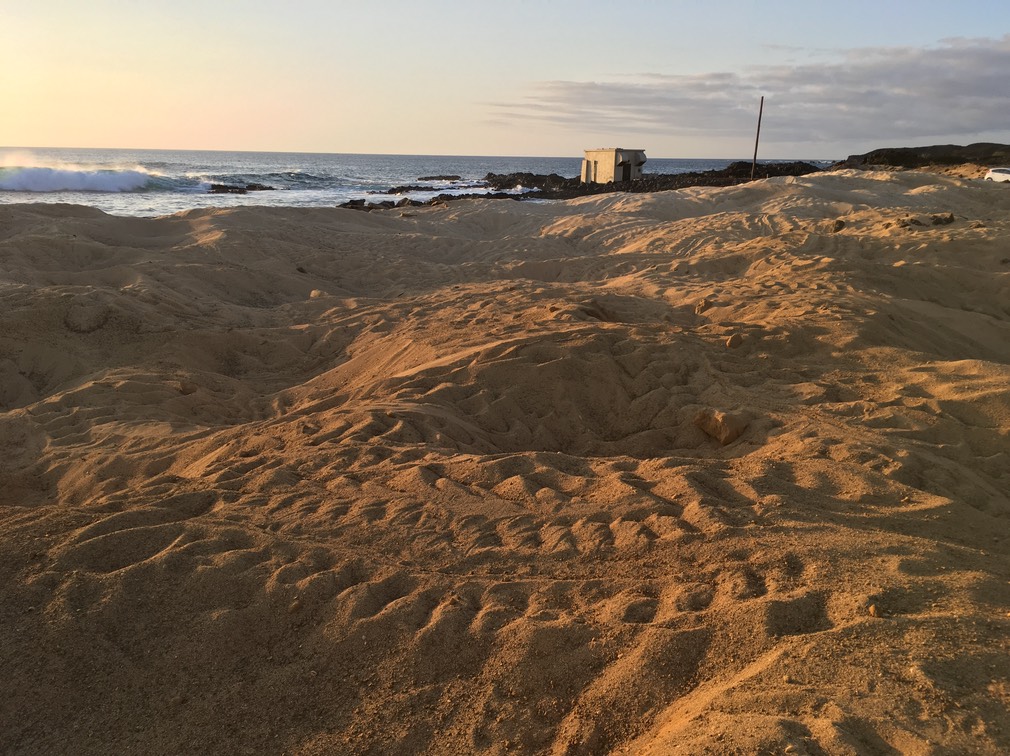
As well as having a wonderful stop in Ascension, we also had a very interesting flight up the middle of the Atlantic to Lajes!
Just after leaving Ascension we encountered very fresh pollution from African fires with over 400 ppb of CO (highest we’ve ever measured in flight!). There was dust and fire emissions mixed in together and we sampled this pollution at various altitudes for the first 3 hours of our flight. The chemical forecast from colleagues at NASA Goddard indicated that we would see it but predicted much lower concentrations than we observed. Working out why we had such large differences will be an interesting research question.
After crossing the ICTZ again background concentrations of lots of species increased again just in a mirror image of what we saw going south between Kona and Fiji.
**************************************************************************************
Updates from the field will be made on Twitter by various people (search for #NASA_ATom or just click here for a full overview: #NASA_ATom

RF07 - 13 February 2017
ATom-2 RF07 13 February 2017 Punta Arenas - Ascension
Our seventh research flight travelled north Punta Arenas, Chile to the small south Atlantic Island of Ascension. We left PA at a respectable 8am as runway repairs ran over in time. This meant we landed in Ascension just after dark. I had asked for the jump seat in the cockpit for landing into Ascension in the hope of seeing a cool view but unfortunately we just missed the sunset.
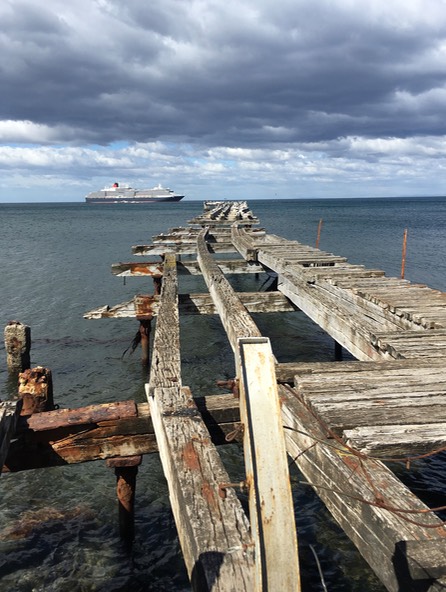
A lot of the crew have spent a lot of time in Punta Arenas for various missions and knew the area well. We found even more great restaurants and the atmosphere around town on a Saturday afternoon was great! In stark contrast to Sunday when the place is deserted!
I was hoping to see penguins in Punta Arenas but unfortunately that didn’t work out. With a day lost, we didn’t have time to go on an all day trip out to the island. It was disappointing but I did get to see an inventive use of tyres!
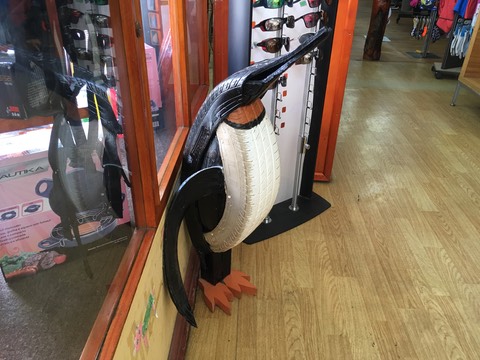
We started preflight in the dark and the sun rose as we prepared to depart Punta Arenas for Ascension

The flight into Ascension landed in the dark but it was still impressive! The air in Ascension was much cleaner than our visit in August where fires from Africa dominated the air although there was some evidence of pollution.
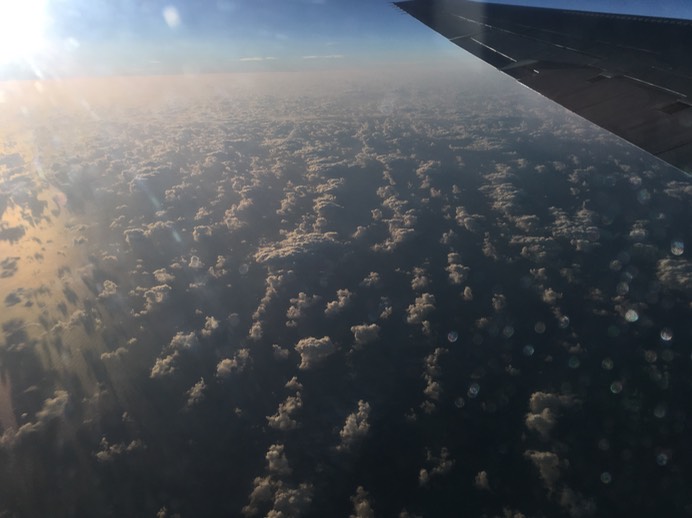
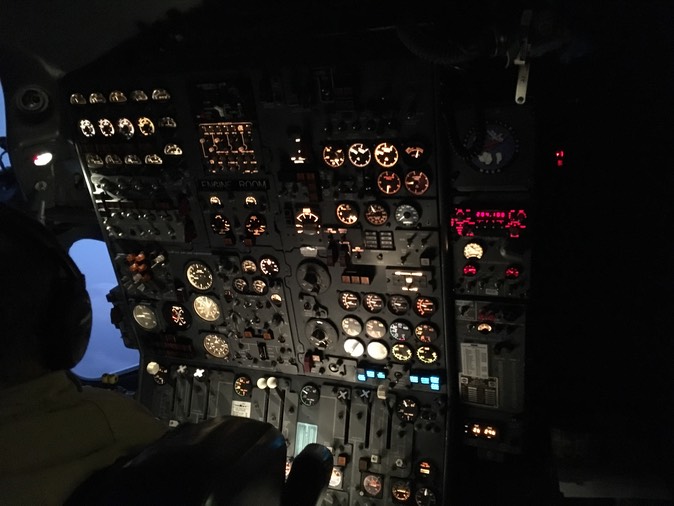
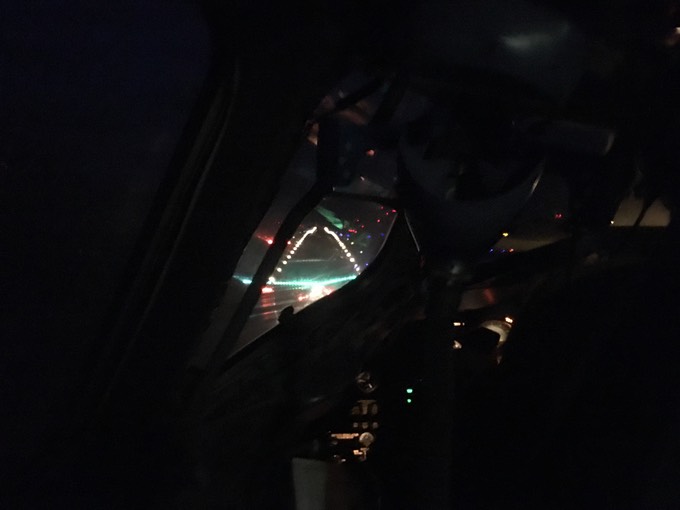
**************************************************************************************
Updates from the field will be made on Twitter by various people (search for #NASA_ATom or just click here for a full overview: #NASA_ATom

RF06 - 10 February 2017
ATom-2 RF06 10 February 2017 Christchurch - Punta Arenas
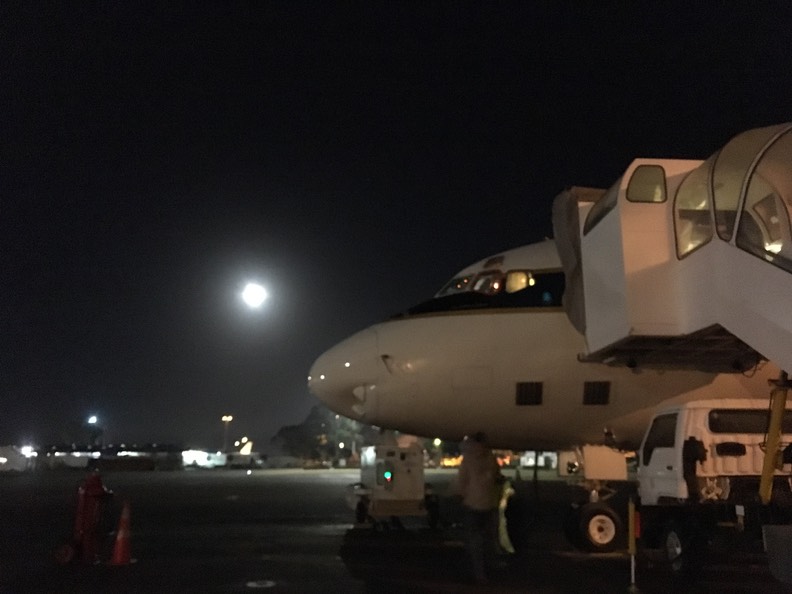
Our sixth research flight travelled back in time from Christchurch, New Zealand to Punta Arenas, Chile! We left Christchurch at 8am on the morning of February 11th and arrived in Punta Arenas at 2am on the morning of February 11th. Between time zone changes and flying east at high latitudes, we gained back the day we lost arriving in Fiji.
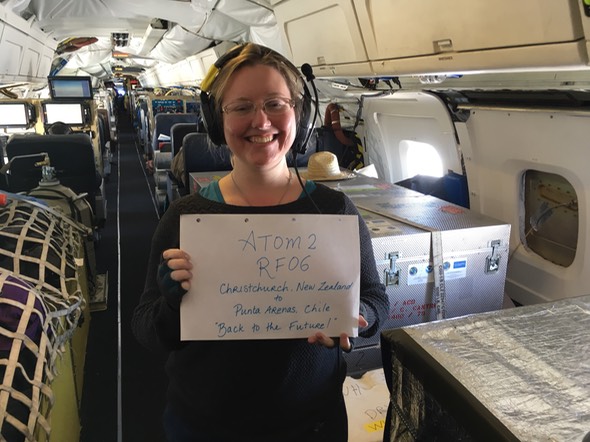
We had originally planned to leave CHC on Feb 10th but strong cross winds made landing in Punta Arenas a risk the pilots weren’t allowed to take. So 90 minutes before take off, we scrubbed our first flight on ATom and trudged back to the hotel. We have been very lucky that no flight was delayed during ATom1 and Christchurch was a nice please to be delayed for a day this time.
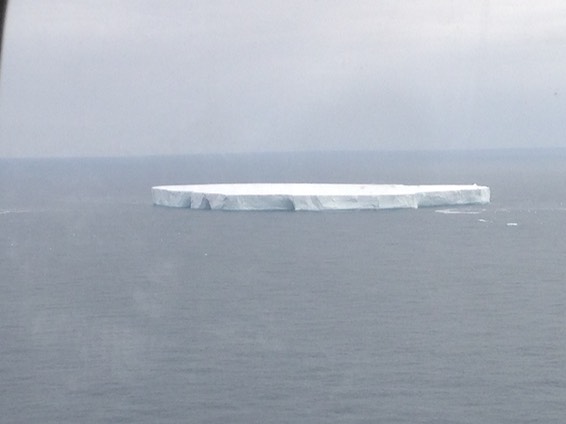
On this flight we saw a faint but persistent signal of African fires throughout the troposphere. We sampled up into the stratosphere too. Except for some CO2 drawdown over the ocean, this flight was quite similar to the southern flight on ATom1.
The southern most point of our flight over the southern ocean was successfully spent looking for icebergs when not sampling the stratosphere. This photo was taken by Eric Ray, NOAA.
Overall we had a great flight and the 2am landing, 3.30am hotel breakfast, 5am bed, wasn’t as difficult as last time!
**************************************************************************************
Updates from the field will be made on Twitter by various people (search for #NASA_ATom or just click here for a full overview: #NASA_ATom.

RF05 - 05 February 2017
ATom-2 RF05 05 February 2017 Nadi - Christchurch
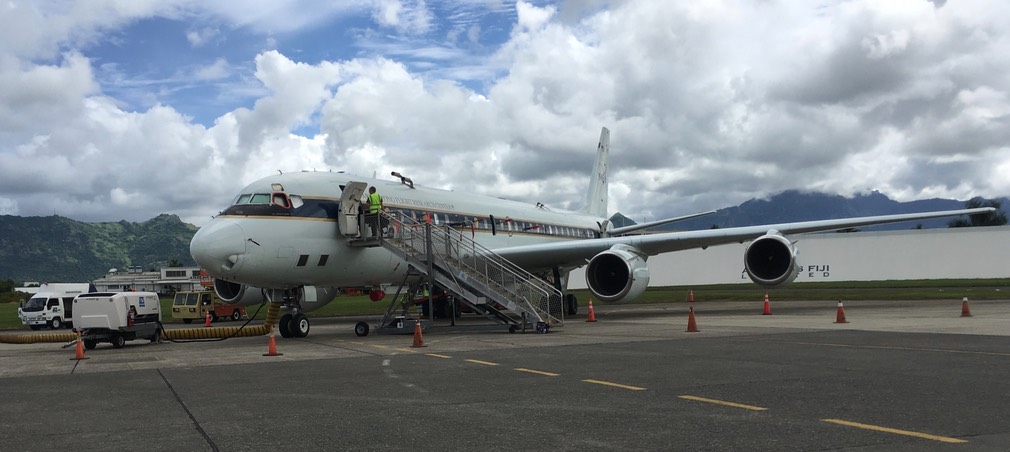
Our fifth research flight brought us from Nadi, Fiji south to Christchurch, New Zealand, with a little zigzagging across the international date line. Pre-flight cooling induced a little condensation on the outside of the aircraft. The video of that and the sunrise is available here.
It takes a lot of energy to get our overstuffed aircraft off the ground, so after our usual lumbering take off (video here), we flew due south, past New Zealand to 63S and looped back up to Christchurch. Unfortunately we missed a profile over Lauder as the site was completely clouded over. Lauder has a long-term TECCON site which measures profiles of CO2, CH4, CO, etc. between the surface and the sun.
Yesterday’s volleyball game had some sun-related casualties.
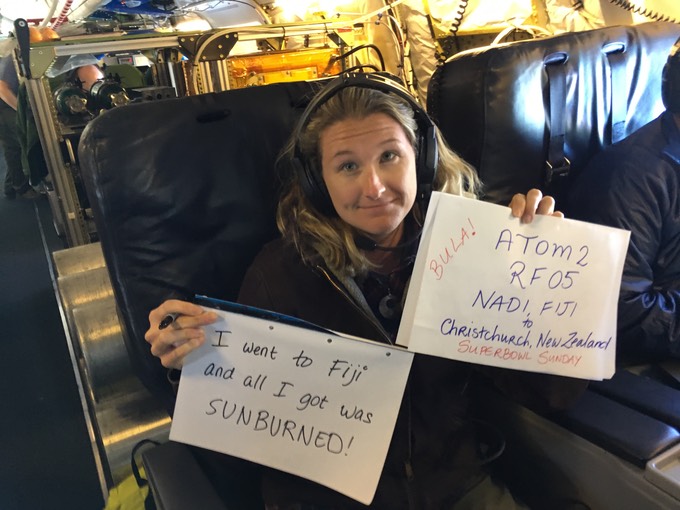
With the time change, we were flying during the Super Bowl (American Football national final) where the Falcons played the Patriots in Houston. The aircraft was under a sports embargo through the whole flight so no-one spoiled the result for anyone else. I polled the aircraft and found a nearly even split of Falcons and Patriots fan, although those against the Patriots really seemed to hate them! I don’t know enough about American football to get all the reasons why but I do enjoy watching it. It’s no substitute for a good rugby game but its not a bad replacement! Matt Berry and Dave Tanner from Georgia Tech in Atlanta (pictured) managed to set up a projector for us to watch it at the hotel on arrival and it was definitely worth staying up for! Sorry Dave!
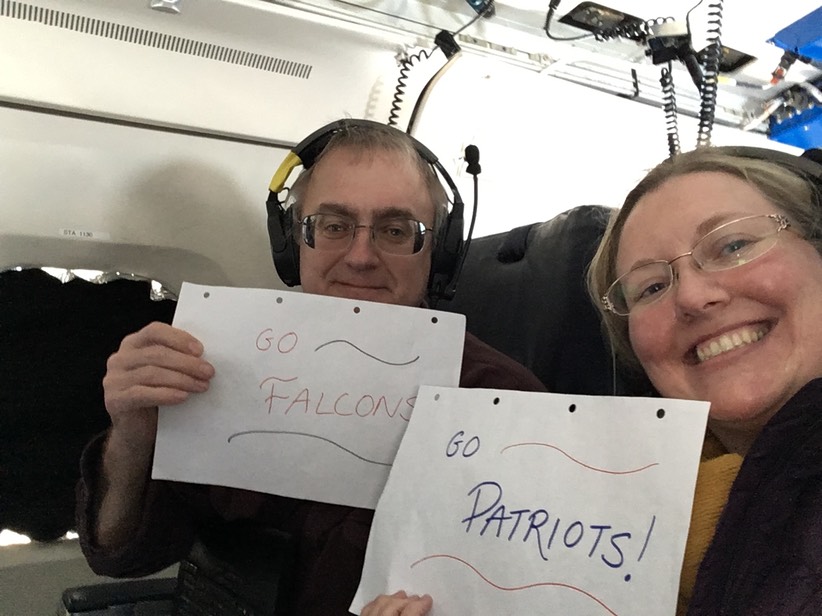
This is austral summer and New Zealand sees a lot more sunshine that on our trip last August. This was a flight of contrasts where we saw CO2 uptake over the southern ocean and an extensive pollution layer between 4 and 9 km. Overall the Pacific was a lot cleaner on ATom1 in August than ATom2 in February and the models attributed much of that pollution to fires in Africa!
**************************************************************************************
Updates from the field will be made on Twitter by various people (search for #NASA_ATom or just click here for a full overview: #NASA_ATom.

RF04 - 03 February 2017
ATom-2 RF04 03 February 2017 Kona - Nadi
Our fourth research flight brought us from to Kona, Hawaii to Nadi, Fiji across both the equator and over the international date line a number of times. As we departed from Kona, the winds were picking up and the volcanic smog (vog) was beginning to lift from over the island.
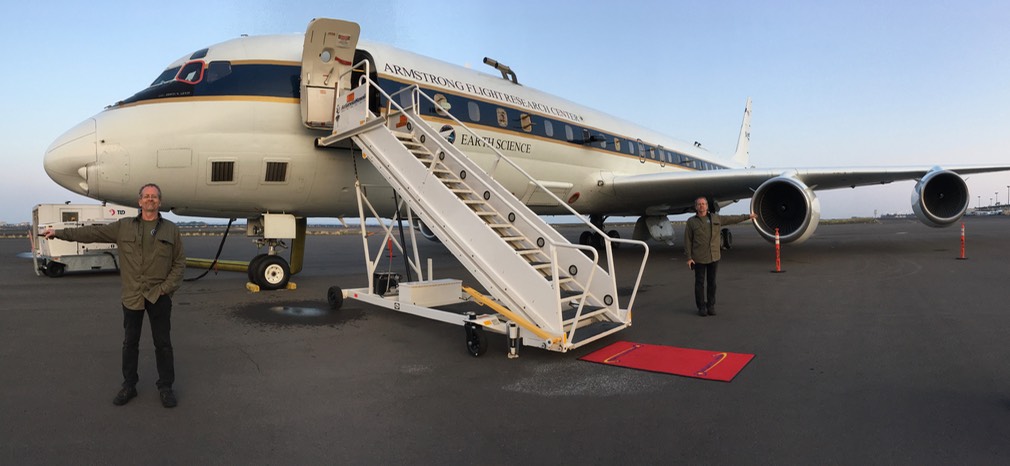
We crossed the chemical equator at about 2oN when all the long lived gas species dropped. The southern hemisphere is a much smaller source of most human emitted gases and mixing between the northern and southern hemisphere is slow so concentrations of many trace gases are smaller: CO went from background values of about 80 ppb to less than 50 ppb, while CO2, CH4, O3, NOy all dropped at the same time.
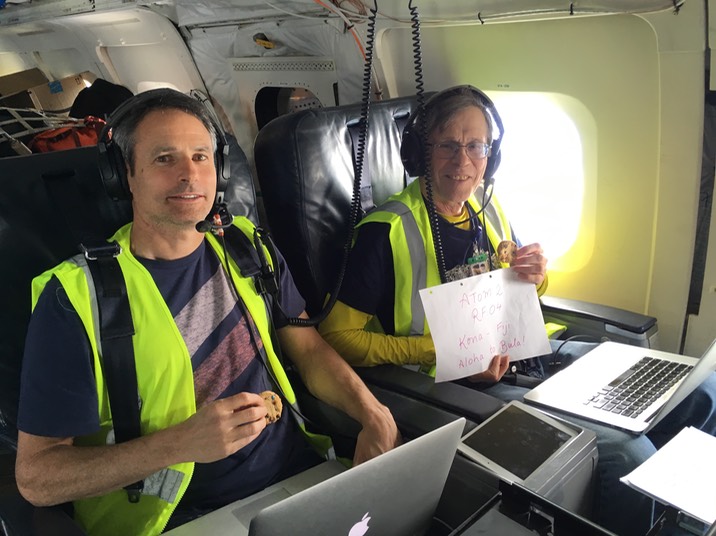
We had to modify our planned flight track as large scale weather systems spang up as we completed our flight. Meteorologist Eric Ray was on hand to advise our navigator Steve to allow us to replot our course. Here Steve Wofsy and Eric Ray (Mission Science) pose with an RF04 poster.
When we landed in beautiful and green Fiji, we rented cars to bring us to the hotel. It was good to be back driving on the ‘correct’ side of the road although getting back into left hand drive thinking took a little time after 9+ hours of flying.
We spent the morning of our day in Fiji at the aircraft preparing for RF05 the next day but that left us a little time to get groceries. And an epic volley ball game developed between scientists and crew before dinner while I lounged in the shade of the pool (I’m too short to be useful at volleyball!). The only winner from that game seemed to be the sun who managed to claim a few sunburn victims.
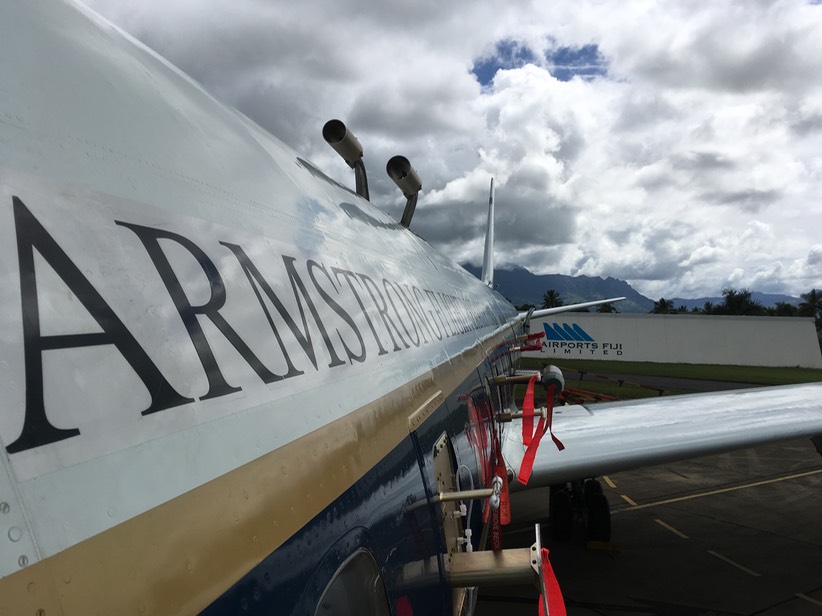
**************************************************************************************
Updates from the field will be made on Twitter by various people (search for #NASA_ATom or just click here for a full overview: #NASA_ATom.

RF03 - 01 February 2017
ATom-2 RF03 01 February 2017 Anchorage - Kona
Our third research flight brought us from Anchorage, Alaska to Kona, Hawaii through both very clean and very polluted air.
We brought warm weather with us from California and Anchorage was a toasty 20-30F (right around freezing). This was much warmer than the week before, which was below negative F! Anchorage has finally experienced above average snow for the first time in a few years and every local I spoke with was thrilled! Boston residents would not be as happy :) In Anchorage, we were stationed in the Fedex maintenance hanger at the airport and the area around the instruments reached 35oC before take off!
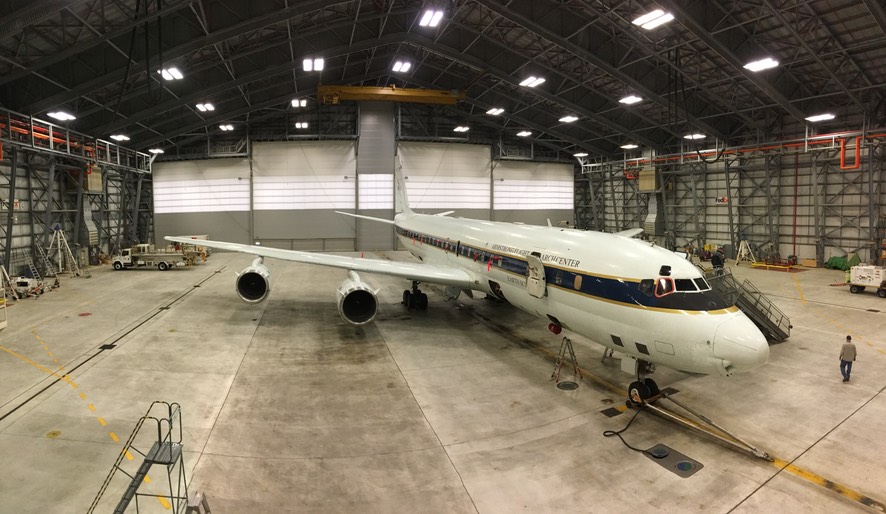

For our day in Anchorage, the mountains were shrouded in cloud but on the morning we left we finally saw the mountains behind Anchorage as the cloud descended even further to let the mountains peak through.

After leaving Anchorage we weaved our way through the volcanic mountains of the Aleutian Islands. We descending to 12 feet over the runway of Cold Bay as we completed a missed approach. A video of the missed approach is available here
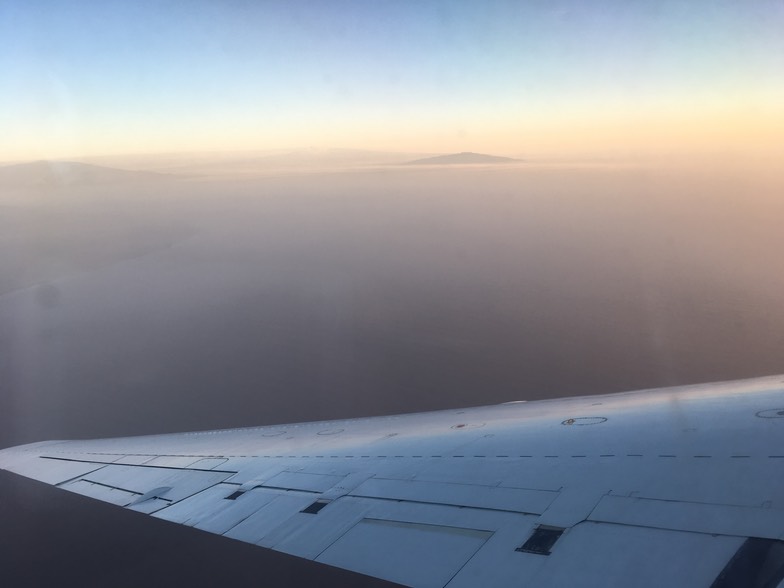
After many profiles in which we sampled both clean air and air influenced by Asian pollution, we descended to Hawaii to find the thickest layer of volcanic smog I’ve ever seen. We could barely see Mauna Loa peeking out through the haze. The volcanic smog was from Kilueua, the volcano which is currently flowing into the sea on the south coast of the big island, and the largest source of SO2 in the USA. Unfortunately we couldn’t even see the ground coming into land so I missed that view. We saw large amounts of sulfur in the haze layer but we also saw a surprisingly large amount of organic species, suggesting that local pollution (possibly from the north) was also making the haze a little thicker.
**************************************************************************************
Updates from the field will be made on Twitter by various people (search for #NASA_ATom or just click here for a full overview: #NASA_ATom.

RF02 - 29 January 2017
ATom-2 RF02 29 January 2017 Palmdale - Anchorage
Our second research flight brought us from Palmdale, California to Anchorage, Alaska.
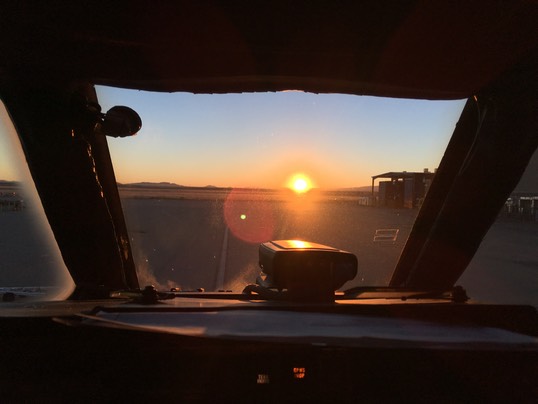
Doors opened at 6.30am just as the sun was rising on Palmdale and we had many hours of twilight as we dipped over Deadhorse and Barrow (now know as Utqiaġvik on the north coast of Alaska. Sunrise in Palmale from the cockpit of the DC8 looked pretty special (left).
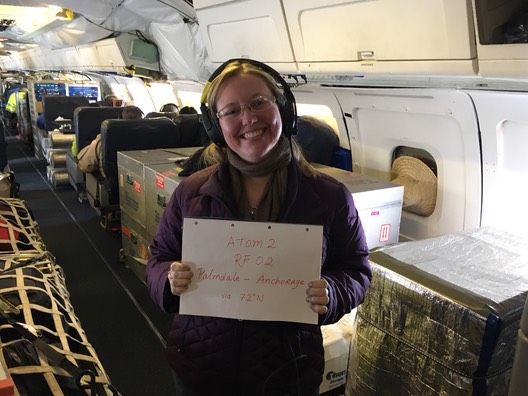
I’m trying to continue taking photos with a sign indicating the flight. It’ll be a good way to tell how much we age through the whole project!
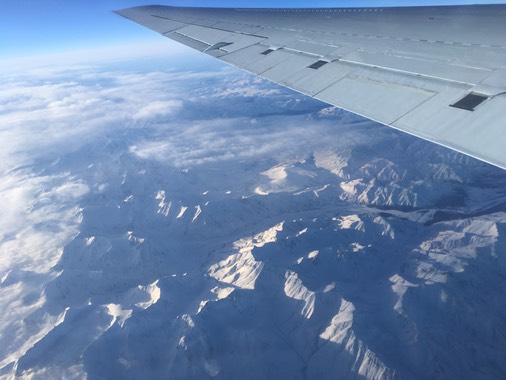
While most of our flight sampled tropospheric air, we also sampled air in the stratosphere, with ozone mixing ratios topping out at 990 ppb - we were taking bets (for bragging rights) on ozone hitting 1 ppm (1000 ppb) but alas, we didn’t see it. In the stratosphere, the CO was the lowest I’ve ever seen (17 ppb) and N2O also dropped and we estimated that the air in the stratosphere last saw the surface of the earth about 6 years ago. It was like looking back in time! CO and N2O are low in the stratosphere for different reasons; CO only lives for a month (on average) and doesn’t mix into the stratosphere but N2O gets destroyed by the same UV light that produces ozone in the stratosphere.
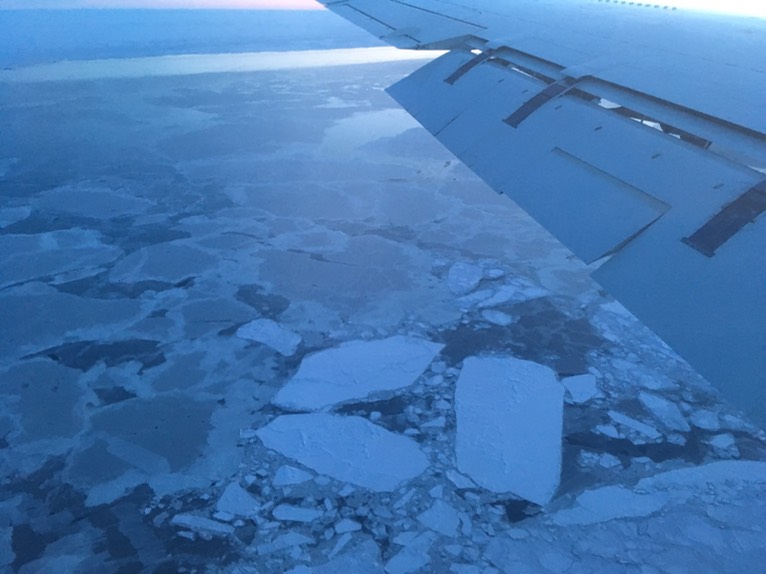
There was just enough light in twilight for us to see the thin and broken sea ice just to the west of Barrow. By the end of January, the sea ice is usually more complete and thicker but 2016 saw the minimum of both arctic and antarctic sea ice, which hasn’t yet recovered.
After seeing the broken and new sea ice at 78oN last August, I’m not as surprised about the lack of solid sea ice near Barrow but it was still disappointing to see…
I posted videos of our 500 ft run over the Gulf of Alaska and our missed approach at BRW to Twitter. Click on the links to watch those videos.
**************************************************************************************
Updates from the field will be made on Twitter by various people (search for #NASA_ATom or just click here for a full overview: #NASA_ATom.

ATom1
ATom-1 Overview
ATom-1: 29 July - 23 August 2016 Completed
Integration of most instruments was completed in early July 2016, with test flights beginning in mid July, 2016.
A number of articles were written about the project during Phase 1 of ATom. Those articles include:
Nomadic Scientists: From Desert to Arctic and Beyond
After a brief trip down to 5oN and up to 78oN, the NASA DC8 aircraft successfully flew down the Pacific basin, across the southern ocean, and back up the Atlantic (via the Greenalnd Ice sheet) to land back in California.
Flights were (YYYYMMDD, Departure, Arrival)
20160729: RF01 Palmdale, CA - Palmdale, CA
20160801: RF02 Palmdale, CA - Anchorage, AK
20160803: RF03 Anchorage, AK - Kona, Hawaii
20160806: RF04 Kona, Hawaii - Pago Pago, American Samoa
20160808: RF05 Pago Pago, American Samoa - Christchurch, New Zealand
20160812: RF06 Christchurch, New Zealand - Punta Arenas, Chile
20160815: RF07 Punta Arenas, Chile - Ascension Island
20160817: RF08 Ascension Island - Lajes, Azore Islands
20160820: RF09 Lajes, Azore Islands - Kangerlusuuaq, Greenland
20160822: RF10 Kangerlusuuaq, Greenland - Minneapolis, MN
20160823: RF11 Minneapolis, MN - Palmdale, CA
During ATom-1, some of the scientists (including me!) wrote blog posts describing the day-to-day activities. Links to my posts are on the ATom Field Blog page.
NASA also produced some excellent videos to descibe our mission using some of my sketchy attempts at videography as well as their own footage from the Palmdale-Palmdale flight. Links to these videos are on the ATom Videos page.
Updates from the field were made on Twitter by various people (search for #NASA_ATom or just click here for a full overview: #NASA_ATom.
ATom1 data has been released to the public and can be found on the NASA ESPO archive.

ATom-1 Blog Entries
The NASA Earth Observatory ‘Notes from the Field” Blog published our blog submissions during ATom-1. You can see a full list of the posts at the following link:
http://earthobservatory.nasa.gov/blogs/fromthefield/category/atom-2016/
I posted shorter updates to the @Atom_Harvard twitter feed as well as my own @rose_Atmos account with the tag #NASA_ATom and #EarthExpedition
Blog Posts
August 2, 2016: Departing for Cooler Climates

August 19, 2016: Going back in Time
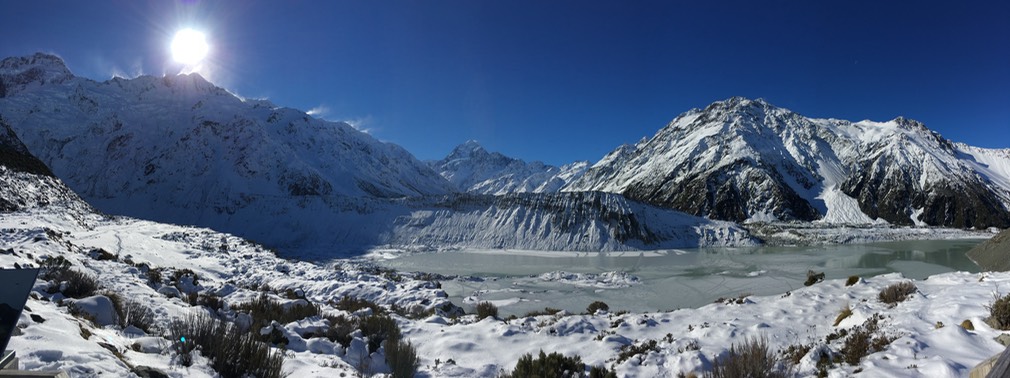
August 26, 2016: Is there any such thing as remote clean air?
August 29, 2016: Challenging Back Half
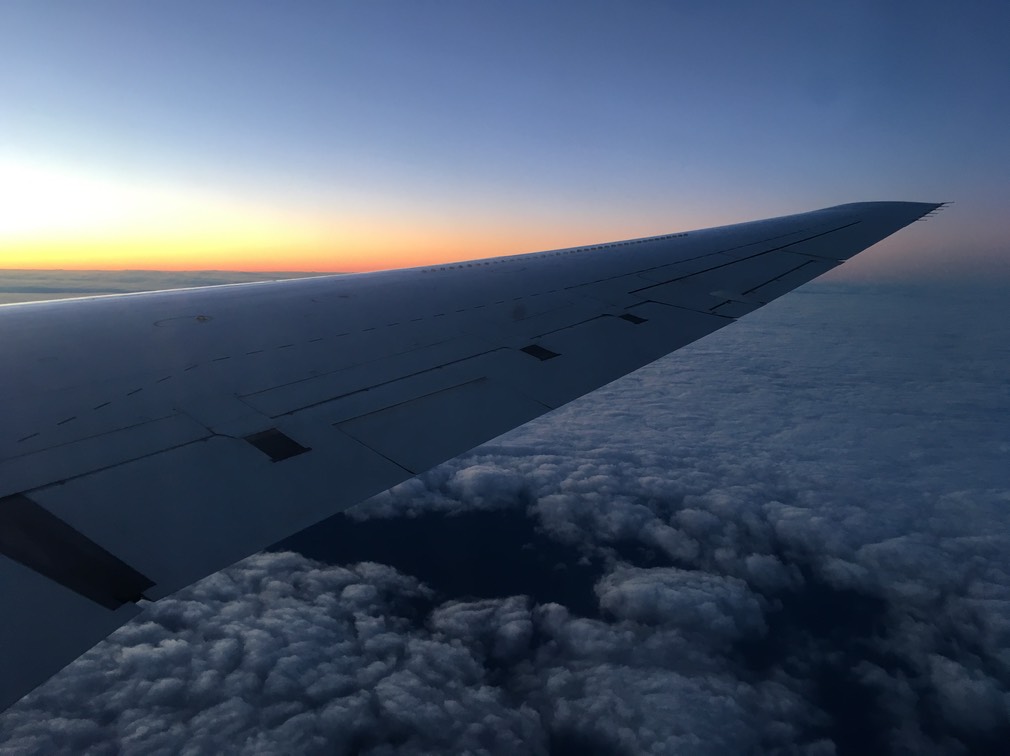
August 30, 2016: Lessons learned
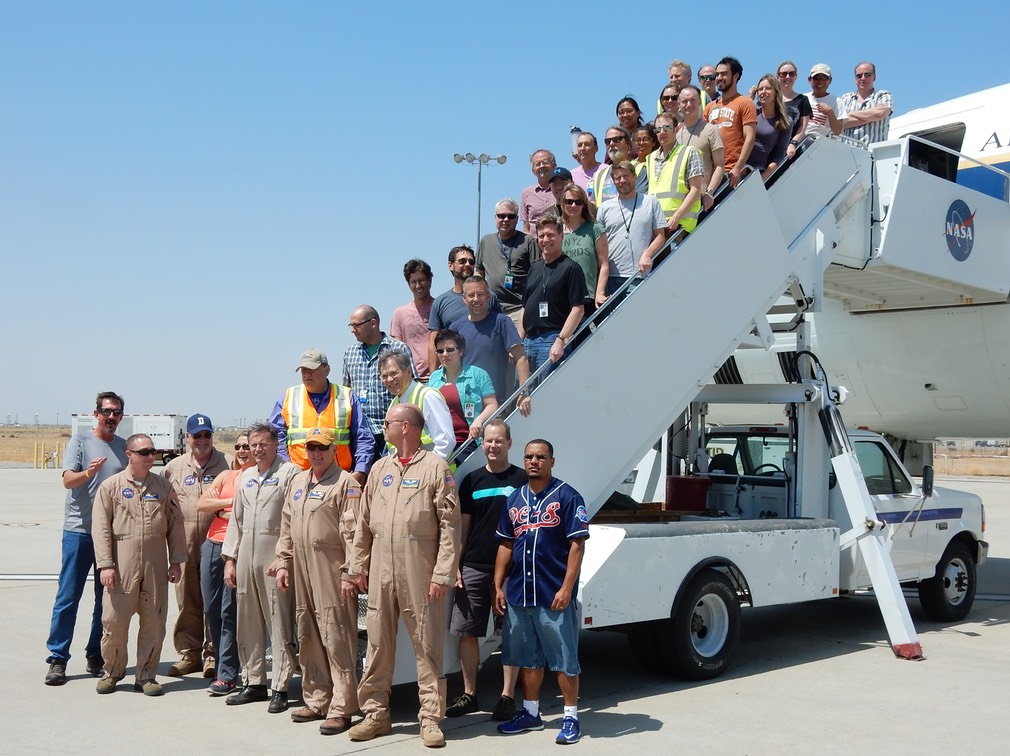

ATom-1 Videos
NASA produced various videos of ATom-1, from both their own footage and my badly taken footage. The Postcards from the field describe the flights and the instrument updates describe some of the measurements.
These were also posted to the @Atom_Harvard twitter feed as well as my own @rose_Atmos account with the tag #NASA_ATom and #EarthExpedition
Postcards from the Field, where I’ve mainly been the videographer, with the occasional speaker role:
ATom Postcard #1: Anchorage to Kona
ATom Postcard # 2: American Samoa to Christchurch
ATom Postcard #3: Punta Arenas, Chile to Ascension
ATom Postcard #4: Azores to Greenland to home
Instrument Descriptions
NASA Earth also posted a number of videos on the instrumentation used on ATom to Facebook:
ATom measures Greenhouse Gases
Other Videos
NASA Earth Expeditions Episode 5 (last 4 mins-ish is about ATom)

ATom-1 Test Flight #1
TEST FLIGHT #1
The first test flight of the NASA ATom project is currently underway! With lots of training of new operators going on, I am on the ground watching the feed from the aircraft.
The DC-8 aircraft was moved ouside of the hanger at Armstrong Flight Research Center at 7 am this morning. The seering desert heat caused some instruments to overheat during the three hours before take off. But the aircraft cooled down rapidly as it went up in altitude and all were sampling within the first hour.
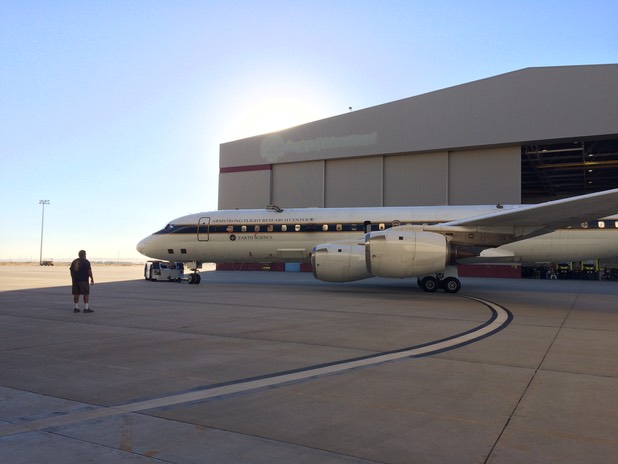
I am anxiously awaiting the return of the aircraft just to see how everything went. Then I have to analyse all the data and submit it to the archive within 24 hours. Having all the data submitted by then will help the lead scientists to ensure all the instruments are working as expected and that the science questions can be addressed.
On another note, these stylish bikes are the favoured way for the DC-8 crew to get around the huge hangers.
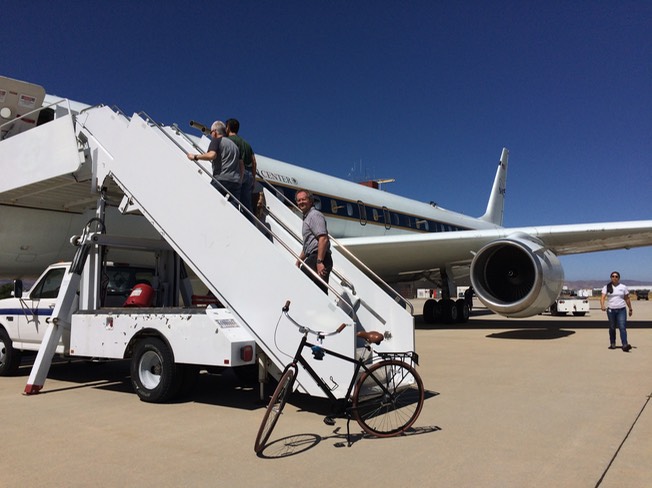
CARVE

CARVE: Carbon in the Arctic Reservoirs Vulnerability Experiment
October 2015
We have completed flights for 2012, 2013 and 2014, with flights to most regions of Alaska each month (April-November) over the three years.
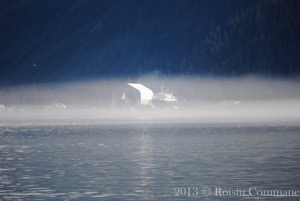
Alaska is a beautiful state and here are some photos take while in Fairbanks and Seward before and after measurements.
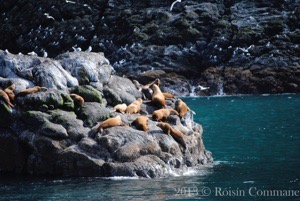
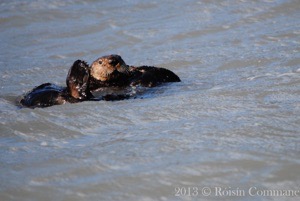
Sea Otters and Sea Lions in Ressurection Bay, near Seward.
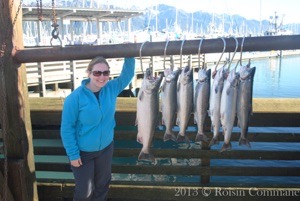
Turns out I wasn’t that bad at fishing! I caught the really big silver salmon on the left - I finally have a big fish story!
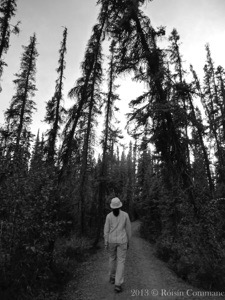


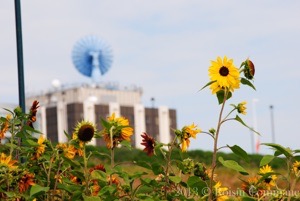
SEAC4RS
Measuring CO2, CO and CH4 high above the US: SEAC4RS
September 2013
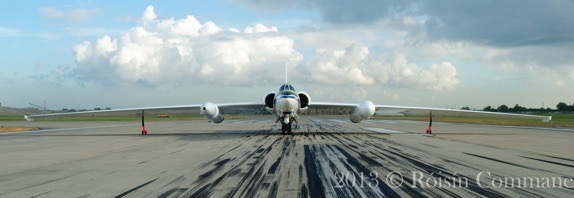
The Wofsy group measured CO2, CH4 and CO in the atmosphere high above the US aboard the ER-2 high altitude aircraft as part of the SEAC4RS project.
I was just helping out on this one but it was a great experience (even with a broken leg)!
All photos by me, with credit to my knee scooter for help carrying the camera.
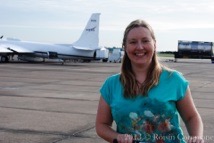
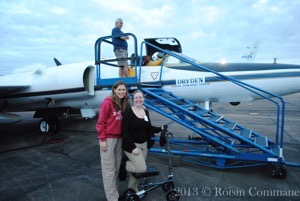
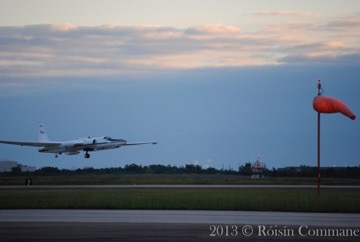
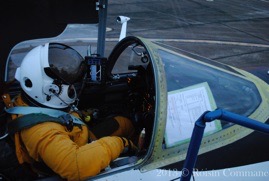
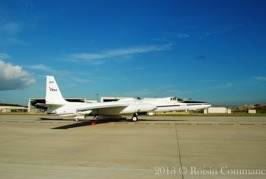
WACS
Measuring OCS from the ocean on the R/V Ron Brown: WACS
September 2012
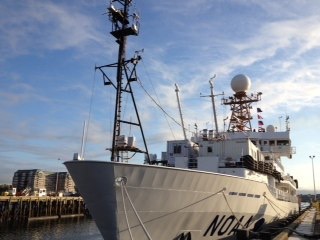
Marine emissions are the dominant source of OCS to the atmosphere. But there is a lot of uncertainty about the global distributions of these emissions.
We calculated the air-flux of OCS by eddy covariance by combining high resolution OCS mixing ratio measurements with motion corrected wind measurements. I ran a QCL instrument to measure fluxes of carbonyl sulfide (OCS) from the jackstaff on the bow of the Ron Brown. Thanks to Ludovic Bariteau, Chris Fairall and Sergio Pezoa at NOAA Boulder, we also ran a sonic anemometer and motion package to determine the true winds impacting the jackstaff.
Scott Herndon and Mark Zahniser (Aerodyne), Martin Graus (NOAA) and Michael Long (Harvard) were all a great help in installing the instrument and sampling lines during the installation period.
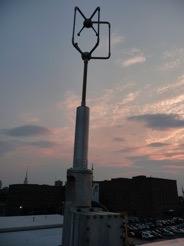
The cruise travelled from the productive waters off the coast of Massachusetts down to the clear blue waters of Bermuda.
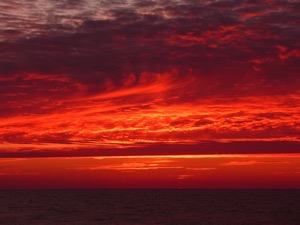
CalNex
Assessing the air quality of California by aircraft and ship: CalNex
August 2010
NOAA P3 aircraft allowed us to flow low over the state of California as part of the CalNex campagin in summer 2010. The WHOI ship R/V Atlantis sampled off the coast and up the river to Sacramento.
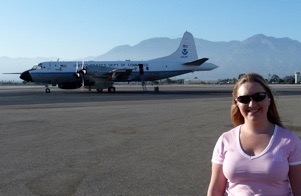
- CalNex Homepage - NOAA P3 - R/V Atlantis
CalNex Publications:
R. Commane, S. C. Herndon, M. Zahniser, B. M. Lerner, J. B. McManus, J. W. Munger, D. D. Nelson and S. C. Wofsy: Carbonyl sulfide in the marine boundary layer: Coastal and continental influences, Journal of Geophysical Research-Atmospheres, CalNex Special Issue, 118, doi: 10.1002/jgrd.50581, 2013
B. Xiang, S. Miller, Eric Kort, G. Santoni, B. Daube, R. Commane, J. Pittman, E. Gottlieb, W Angevine, T. Ryerson, M. Trainer, A. Andrews, T. Nehrkorn, H. Tian, S. Wofsy: Nitrous Oxide (N2O) Emissions from California based on 2010 CalNex Airborne Measurements, Journal of Geophysical Research-Atmospheres, CalNex Special Issue, 118, doi:10.1002/jgrd.50189, 2013
I. B. Pollack, T. B. Ryerson, M. Trainer, D. D. Parrish, A. E. Andrews, E. L. Atlas, D. R. Blake, S. S. Brown, R. Commane, B. C. Daube, J. B. Gilman, J. A. de Gouw, W. P. Dubé, J. Flynn, G. J. Frost, N. Grossberg, J. S. Holloway, J. Kofler, E. A. Kort, W. C. Kuster, P. M. Lang, B. Lefer, R. A. Lueb, J. A. Neuman, J. B. Nowak, P. C. Novelli, J. Peischl, A. E. Perring, J. M. Roberts, G. Santoni, J. P. Schwarz, J. R. Spackman, N. L. Wagner, C. Warneke, S. C. Wofsy, B. Xiang: Airborne and ground-based observations of a weekend effect in ozone, precursors, and oxidation products in the California South Coast Air Basin, Journal of Geophysical Research, 117, D00V05, doi:10.1029/2011JD016772, 2012
